The 1950s, for much of America, were a decade of “I Like Ike” and “We Like Short Shorts” and I Love Lucy. But out on Jacksboro Highway during the 1950s, the boys in the back rooms of the nightclubs and the bars had different druthers: They liked gambling, they liked prostitution, they liked extortion and hijacking, and they loved cops who looked the other way.
Jacksboro Highway gambler Nelson Harris was one of those back-room boys. He had practically grown up on the highway, having worked there in his teens as a club bouncer before the war.
 Harris, along with Charles Beland, also had belonged to the Green Dragon narcotics syndicate, was convicted, and served time at Leavenworth.
Harris, along with Charles Beland, also had belonged to the Green Dragon narcotics syndicate, was convicted, and served time at Leavenworth.
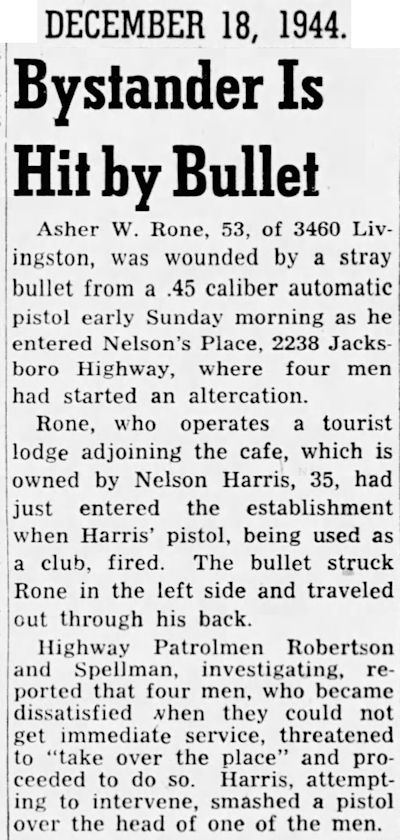
By 1944 Harris was out of prison and owned a cafe/gambling joint of his own at 2238 Jacksboro Highway: Nelson’s Place. Next door was the tourist court of gangster Asher Rone. In December Rone got in the way of a stray bullet as Harris used his pistol as a club during an altercation with four dissatisfied customers.
By 1950 Harris was forty-one years old and married to his second wife, Juanita, age twenty-five. On the morning of November 22—the day before Thanksgiving—Harris phoned two Fort Worth criminal lawyers, Ross and Doss Hardin. Harris was not in a holiday mood. He told the two lawyers that he was coming to see them about a matter of “life and death.”
Soon after he made that phone call, at 9:15 Nelson and Juanita Harris got into their car outside their duplex on Wingate Street near University Drive on the near West Side. Juanita Harris was due to give birth the next week.
Nelson Harris leaned forward to start the car’s engine. He turned the ignition key. A bottle of nitroglycerin wired to the starter blew the car apart. Harris, Juanita, and their unborn child were killed.
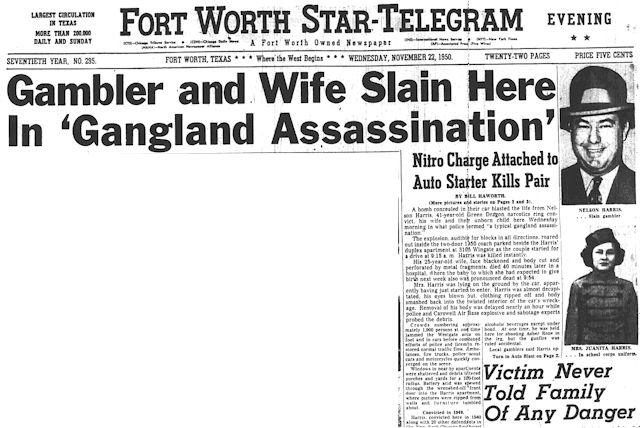 The Harris “gangland assassination” was the lead story on page 1 of the November 22 evening Star-Telegram.
The Harris “gangland assassination” was the lead story on page 1 of the November 22 evening Star-Telegram.
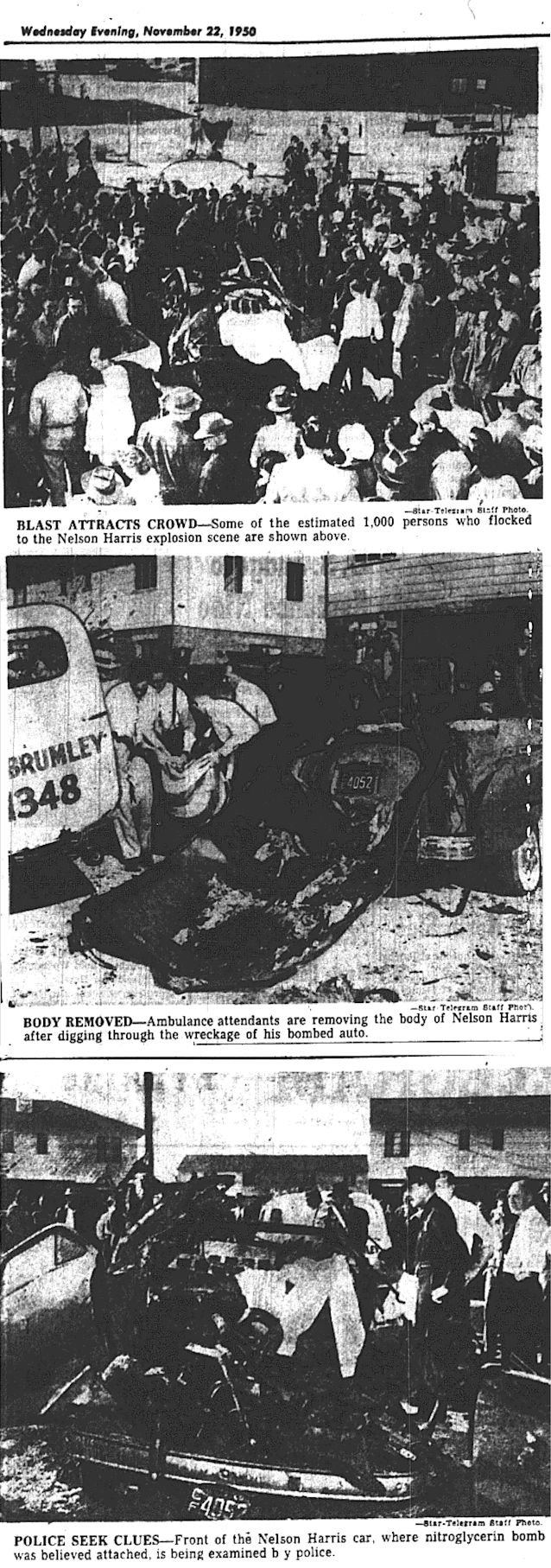
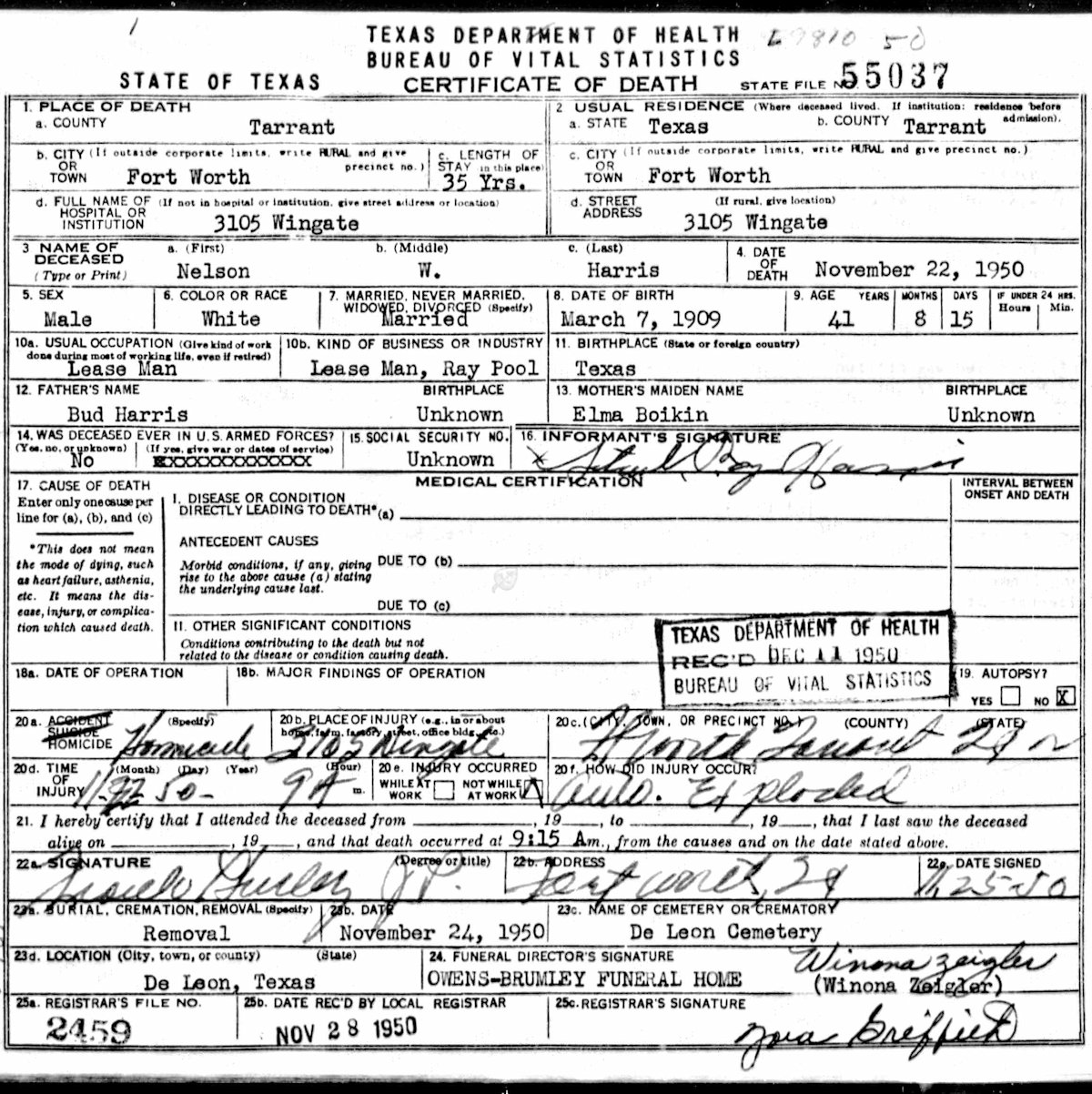
“Homicide/Auto exploded”: Thanks to the boys in the back rooms out on Jacksboro Highway, during the decade to come death certificates, like front-page headlines, would make for livelier reading.
The bomb that blew apart the car of Nelson and Juanita Harris just before Thanksgiving in 1950 also blew the lid off Jacksboro Highway’s underworld.
Fort Worth’s Highway to Hell would never be the same.
Law enforcement and the public had spent the previous decade looking the other way as the hoodlums who controlled the vice on Jacksboro Highway had killed one another off. After all, that had been in-fighting. Thug-on-thug. Every time a gangster killed another gangster, it was one less gangster for police to catch, one less gangster for courts to try. But now, with the Harris murders, someone had killed a woman and an unborn child. The public began to demand action.
The cops had to stop looking the other way.
Vice districts like Jacksboro Highway are organic, not synthetic. No developer plats an area of a city, gets it zoned “S” for “Sodom,” and puts up a billboard proclaiming, “Anything Goes.” Vice districts develop gradually, driven by circumstances. Jacksboro Highway was the reincarnation of Fort Worth’s original vice district, Hell’s Half Acre. But whereas the Acre had developed out of the cattle drives that brought men and money into town, Jacksboro Highway had developed out of a more complex set of circumstances.
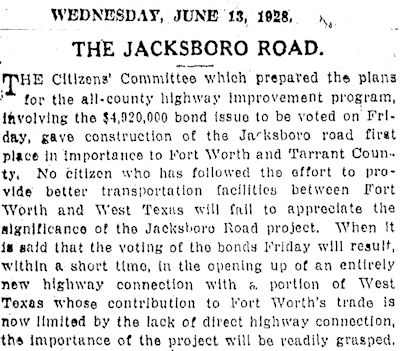 Jacksboro Highway’s location contributed to its evolution. It was in the right place at the right time. In 1928 voters approved bonds to extend State Highway 34 from downtown Fort Worth northwest toward the town of Jacksboro.
Jacksboro Highway’s location contributed to its evolution. It was in the right place at the right time. In 1928 voters approved bonds to extend State Highway 34 from downtown Fort Worth northwest toward the town of Jacksboro.
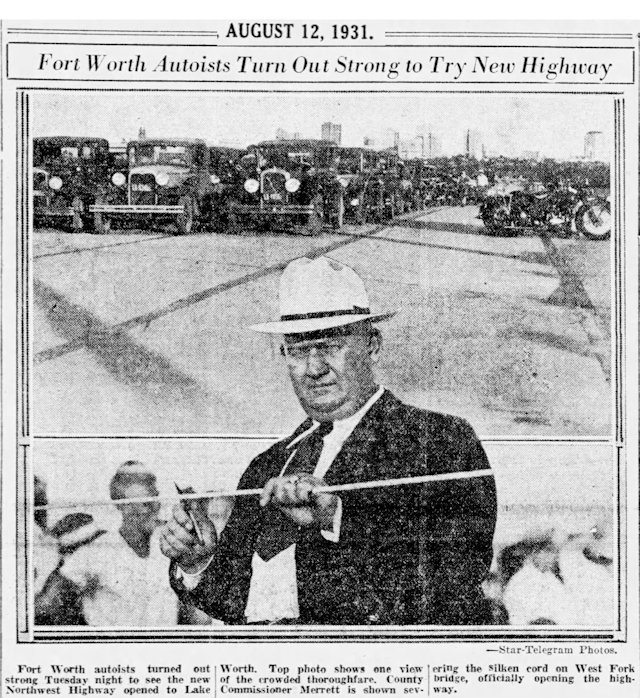 In 1931 State Highway 34—also known as “Northwest Highway”—opened to Lake Worth with a ribbon-cutting ceremony, fireworks at Casino Beach, and music by the Light Crust Doughboys. In 1935 the highway would be redesignated “State Highway 199.” The stretch of highway on the Fort Worth end became known as “Jacksboro Highway.”
In 1931 State Highway 34—also known as “Northwest Highway”—opened to Lake Worth with a ribbon-cutting ceremony, fireworks at Casino Beach, and music by the Light Crust Doughboys. In 1935 the highway would be redesignated “State Highway 199.” The stretch of highway on the Fort Worth end became known as “Jacksboro Highway.”
In 1933 national prohibition ended, but the Texas legislature limited the sale of hard liquor. Many of the counties that Jacksboro Highway connected to Fort Worth were dry. Oilfield workers and ranchers—roughnecks and rednecks—in those dry counties came to Fort Worth to wet their whistle and to gamble on Jacksboro Highway. And the highway was a two-way street: Moonshiners in Tarrant County serviced those dry counties, running Cadillacs and Oldsmobiles and Pontiacs that were souped up and loaded down with liquor out the highway, earning it the nickname “Thunder Road.”
Additionally, in 1936 Fort Worth celebrated Texas’s first one hundred years with its Frontier Centennial. To make that months-long celebration an economic success, the city winked at illegal gambling and open bars. Cops looked the other way.
In 1942 the highway’s location again contributed to its evolution. With America at war, Fort Worth became the home of Air Force Plant 4. Thousands of men and women worked at the plant building B-24 bombers. At adjacent Fort Worth Army Air Field (later named “Carswell Air Force Base”), more men trained in those B-24s. All those workers with a paycheck to spend and a need to relax worked just three miles from the clubs of the “Jax Beer Highway.”
Too, the neighborhoods where the laborers of the stockyards and packing plants lived were even closer—less than a mile away. Even River Crest Country Club, with its high-rolling members, was only three miles away.
Socialites from the affluent West Side, frat boys from TCU looking for adventure, high-stakes professional gamblers, and penny-ante amateurs—the highway offered something for them all.
One more factor in the evolution of the highway: In its early days its upper stretches were beyond Fort Worth city limits and thus beyond Fort Worth police.
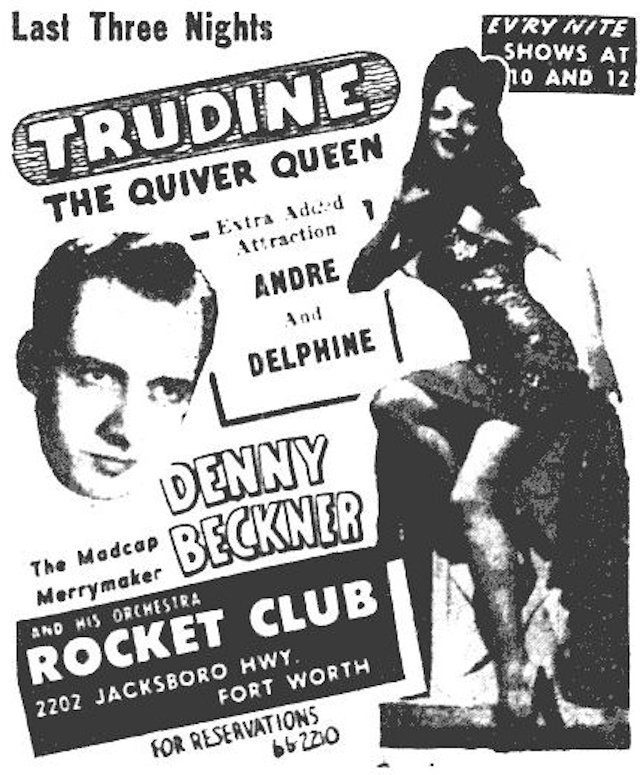 Clubs on the Highway to Hell came and went over the years, of course, but included the Four Deuces, 3939 Club, Black Cat, Black Sands, Hilarity Club, Coconut Grove, Rocket Club, Supper Club, and Showboat. Ad is from a 1948 Fort Worth Press.
Clubs on the Highway to Hell came and went over the years, of course, but included the Four Deuces, 3939 Club, Black Cat, Black Sands, Hilarity Club, Coconut Grove, Rocket Club, Supper Club, and Showboat. Ad is from a 1948 Fort Worth Press.
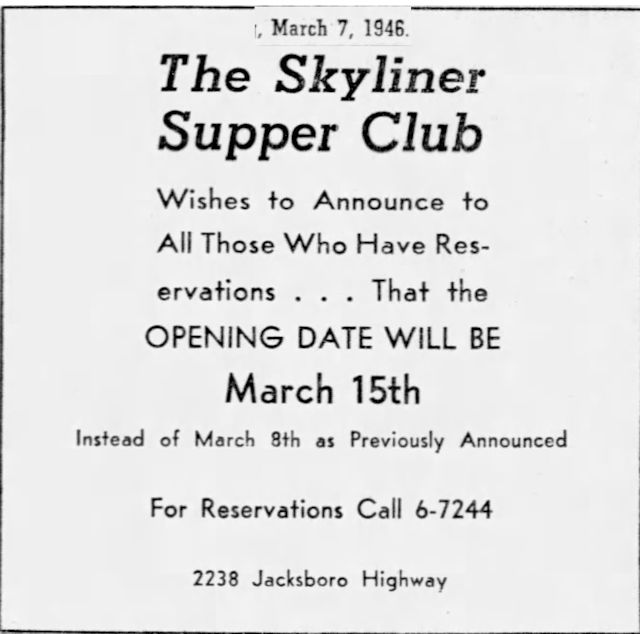

The Skyliner Club and Skyliner Annex Club were built on the site of Nelson’s Place at 2238 Jacksboro Highway. The Annex Club opened in 1950 with Jane Rubey as “mistress of ceremonies and delineator of songs.”
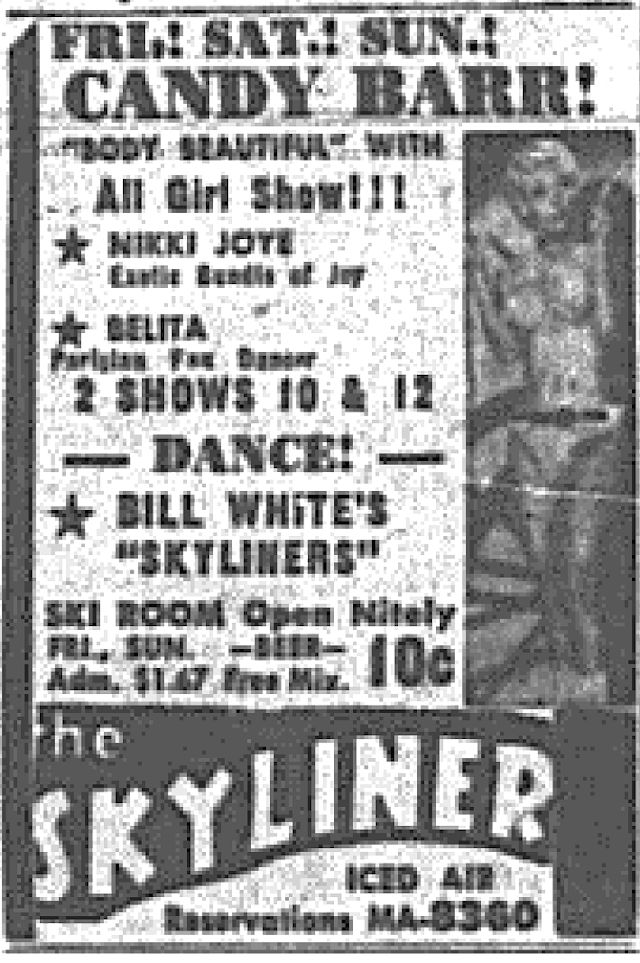 At the Skyliner Club the interpretive dance of terpsichorean Candy Barr enthralled aficionados of the performing arts. Clip is from an August 1955 Star-Telegram.
At the Skyliner Club the interpretive dance of terpsichorean Candy Barr enthralled aficionados of the performing arts. Clip is from an August 1955 Star-Telegram.
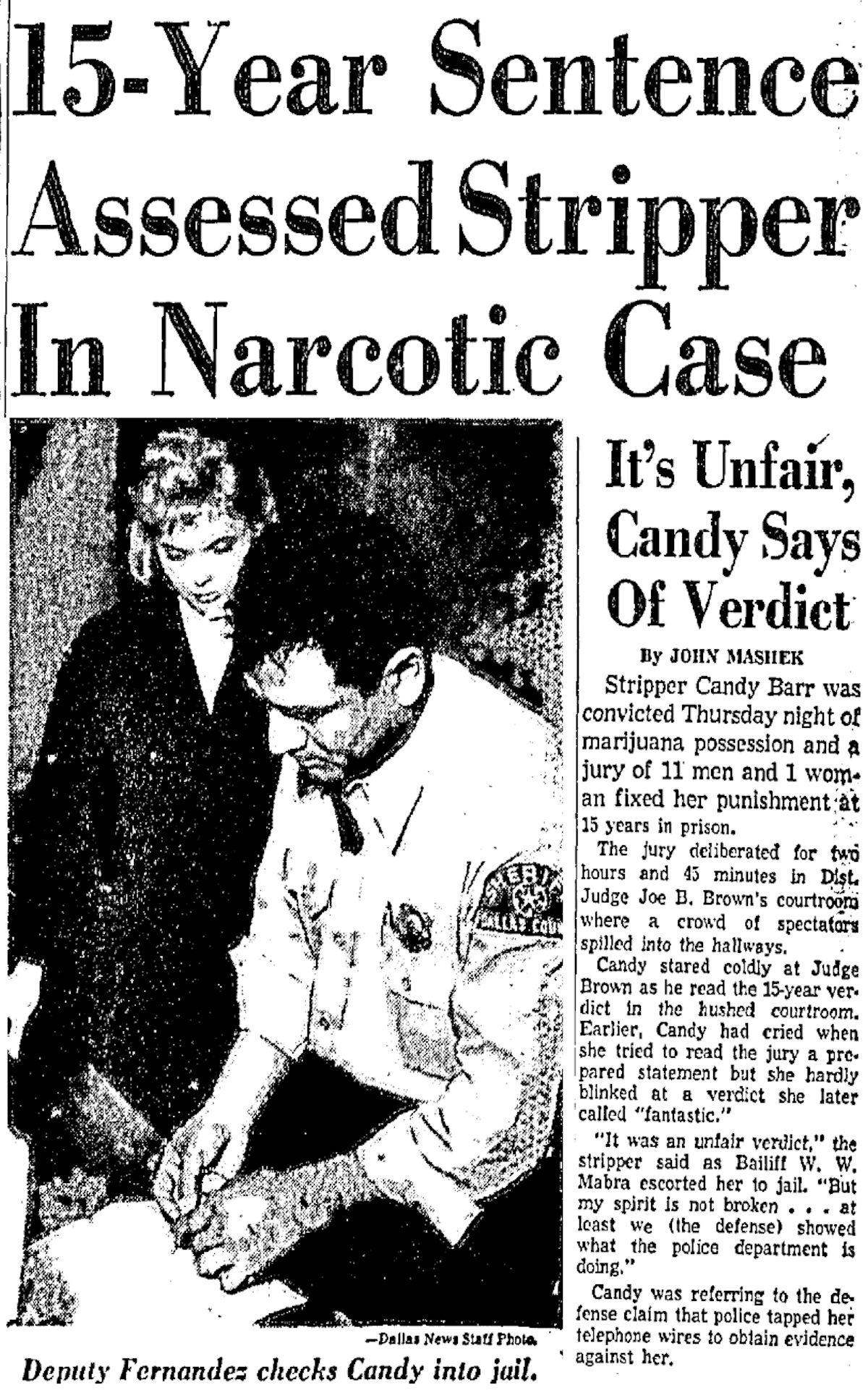
(In 1958 Candy Barr would be convicted of marijuana possession. Clip is from the February 14 Dallas Morning News.)
WBAP-TV archival news footage of Candy Barr:
In addition to stage entertainment, the clubs of Jacksboro Highway offered dining, dancing, and drinking. Also slot machines, cards, dice, roulette wheels, and bookmaking. And for those who were so inclined, a choice of fights: fist, knife, or gun.
The clubs on the highway during the 1950s could be classified as divas or dives. In the diva clubs, well-dressed couples were ushered to polished tables with deference by men in tuxedos. In the dives, drunks were tossed out the back door by bouncers in denim jackets.
The diva clubs featured big-name entertainers: Bob Wills and the Texas Playboys, Andrews Sisters, Paul Whiteman, Dorothy Lamour, Kay Kyser, Tommy Dorsey, Artie Shaw, Benny Goodman, Harry James, and Fort Worth’s own Bobby Peters. The dives had chicken-wire netting stretched in front of the stage to protect musicians such as young Willie Hugh Nelson.
Arguably the top diva club was the Four Deuces, a five thousand-square-foot Spanish colonial casino and restaurant. William Calvin “Pappy” Kirkwood owned and operated the Four Deuces from 1934 to 1972. He also lived on the premises. Admittance to the Four Deuces, so-called because of its 2222 Jacksboro Highway address, was by invitation only. Among the invited: cowboy singer Gene Autry, Speaker of the U.S. House Sam Rayburn, the wife of Star-Telegram publisher Amon Carter, animal collector Frank Buck, and King Ranch board chairman Dick Kleberg.
The Four Deuces was for high-rollers only, players who might win—or could afford to lose—$25,000 in a night. Tens of thousands of dollars changed hands in a night at the Four Deuces.
Not everyone came there to gamble, of course. Some came merely to bask in the ambiance, to enjoy the food and drink—the best steaks, liquor, and cigars—and to rub shoulders, mink on mink, silk on silk, with other members of the social register. On a busy night the parking lot of the Four Deuces looked like a Cadillac dealership.
Pappy Kirkwood’s son Pat, who would later operate the Cellar, had another way of assessing business on the highway. Associated Press writer Mike Cochran wrote in 1988 of Pat: “As a youngster growing up on Jacksboro Highway, Pat Kirkwood scrambled atop the roof of his dad’s gambling joint on Saturday nights and assessed the economy by activities along the road below. ‘If it was a three-ambulance evening, money was a little tight,’ he said. ‘But seven or eight ambulances meant everything was OK. People were out spending money and boozing and brawling.’”
And Pappy ran a straight house, Pat recalled in 1983. “In a place that may or may not be exactly to the letter of the law, the only thing that maintains your business level is absolute integrity.”
For example, a salaried man would not be allowed to gamble at the Four Deuces, Pat recalled, “because he might lose and hurt his family. . . . The first time you take a man’s salary, his wife’s gonna call, there’s gonna be heat, and the man downtown [city government] isn’t going to stand for it. They don’t mind [the gambling place], but they won’t stand for the heat.”
Pappy also dabbled in oil and real estate, but gambling was his passion. Pat said his father was “a pure gambler.”
“Gambling was his whole life.”
Pappy alternately won and lost fortunes.
To Pappy, “really the action was more important than winning or losing. The play, the excitement.”
Pat Kirkwood said: “On many an occasion . . . some high roller would roll in from Midland and demand . . . a heads-up, two-player game with my father. And usually it was a bad decision. As my father explained it to me, ‘As few points as there are on those dice, it’s amazing how few people can count that high.’”
Car-bombed gangster Nelson Harris had once worked as a “yardman” at the Four Deuces. His job was to screen guests as they arrived and to press a buzzer if he saw police officers approaching so that the gambling equipment could be concealed. (Pat Kirkwood said the club also was often tipped off about raids. By the time police arrived, the gambling house was just a cocktail lounge.)
Into the “dive” category of clubs on the highway fell an assortment of establishments. Most offered the wild life.
And one offered wildlife: Elmer Sharp ran a private club in his garage. Doyle Brunson, now a member of the Poker Hall of Fame, recalled Sharp from the 1950s in Brunson’s The Godfather of Poker: “Elmer kept a pet bear at the ‘private club’ he ran illegally out of his garage, and if business or brawling was slow, he’d just wrestle that damn bear.”
 Elmer Sharp was indeed built for bear. He was solid and square shouldered—a refrigerator with five o’clock shadow. Doyle Brunson recalled, “They claimed the only person in town tougher than Elmer was his mama.” (Photo from University of Texas at Arlington Library.)
Elmer Sharp was indeed built for bear. He was solid and square shouldered—a refrigerator with five o’clock shadow. Doyle Brunson recalled, “They claimed the only person in town tougher than Elmer was his mama.” (Photo from University of Texas at Arlington Library.)
Fort Worth suffered a severe case of ambivalence about the highway, just as it had about Hell’s Half Acre a half-century earlier, muttering lamentations for its sin one minute and whispering thanks for its economic engine the next minute. Vice brought people to town, put money into circulation. Calls for reform waxed but always waned. Indignation was always followed by resignation.
And then came the car-bombing of the Harrises on the day before Thanksgiving in 1950.
And yet, seldom can one event be singled out as the last straw. More often there are many last straws that accrue to eventually make a broom. And then the broom begins to sweep. In the case of Jacksboro Highway, after the Harris car-bombing, suddenly police began to find gambling where they had found none before. Arrests were made; equipment was confiscated.
Five weeks after Harris and his pregnant wife were killed in November 1950, a grand jury began to investigate their murders. Then investigators found that Harris was speaking from the grave: He had left behind a trunk full of business records—records pointing to police payoffs.
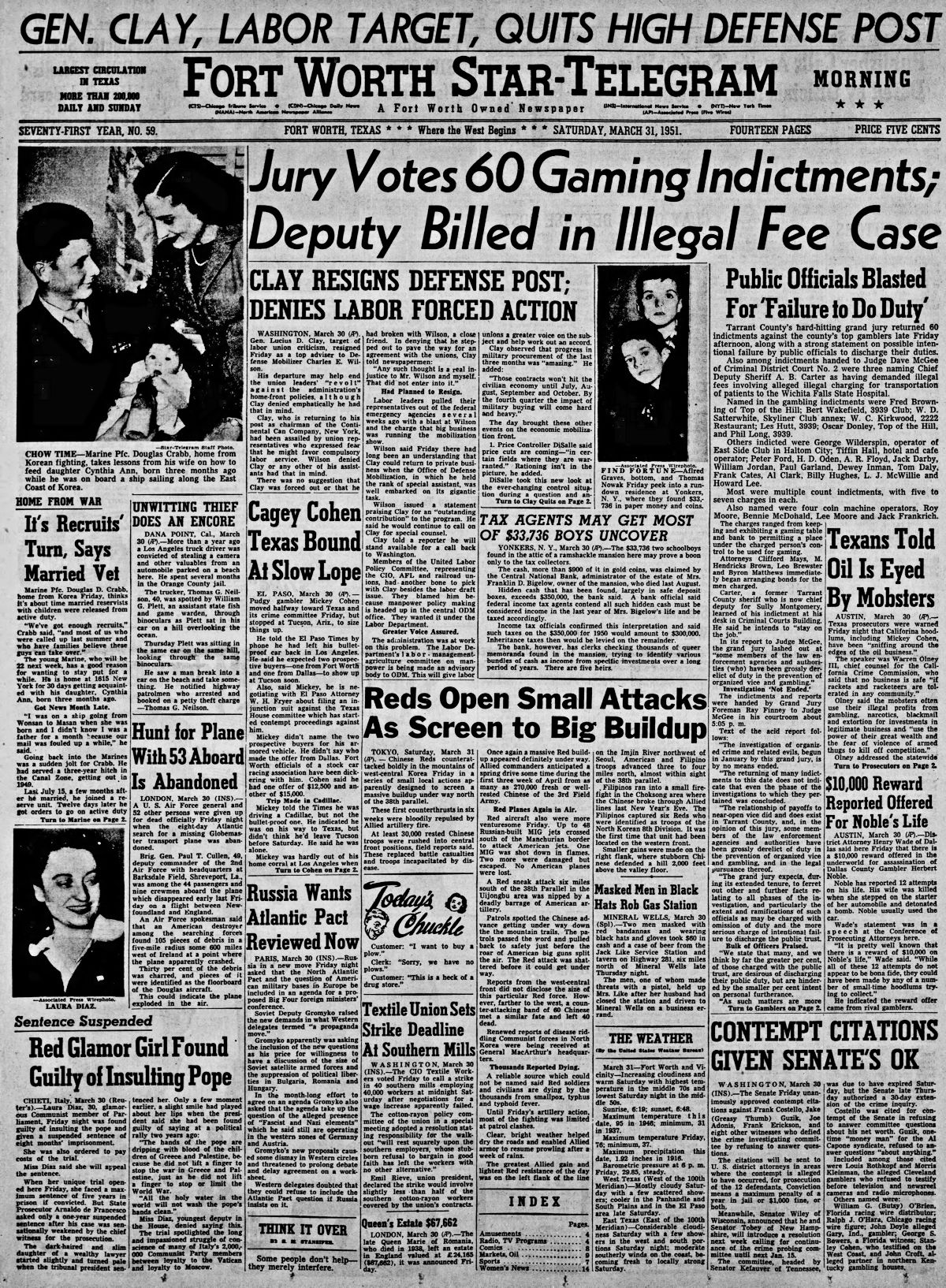 The grand jury widened its investigation to “gaming, bribery, and vice.” After a three-month investigation the grand jury indicted thirty-two gamblers, most of them Jacksboro Highway operators.
The grand jury widened its investigation to “gaming, bribery, and vice.” After a three-month investigation the grand jury indicted thirty-two gamblers, most of them Jacksboro Highway operators.
Rumors circulated: The grand jury would indict police officers for taking bribes.
But a deal was cut.
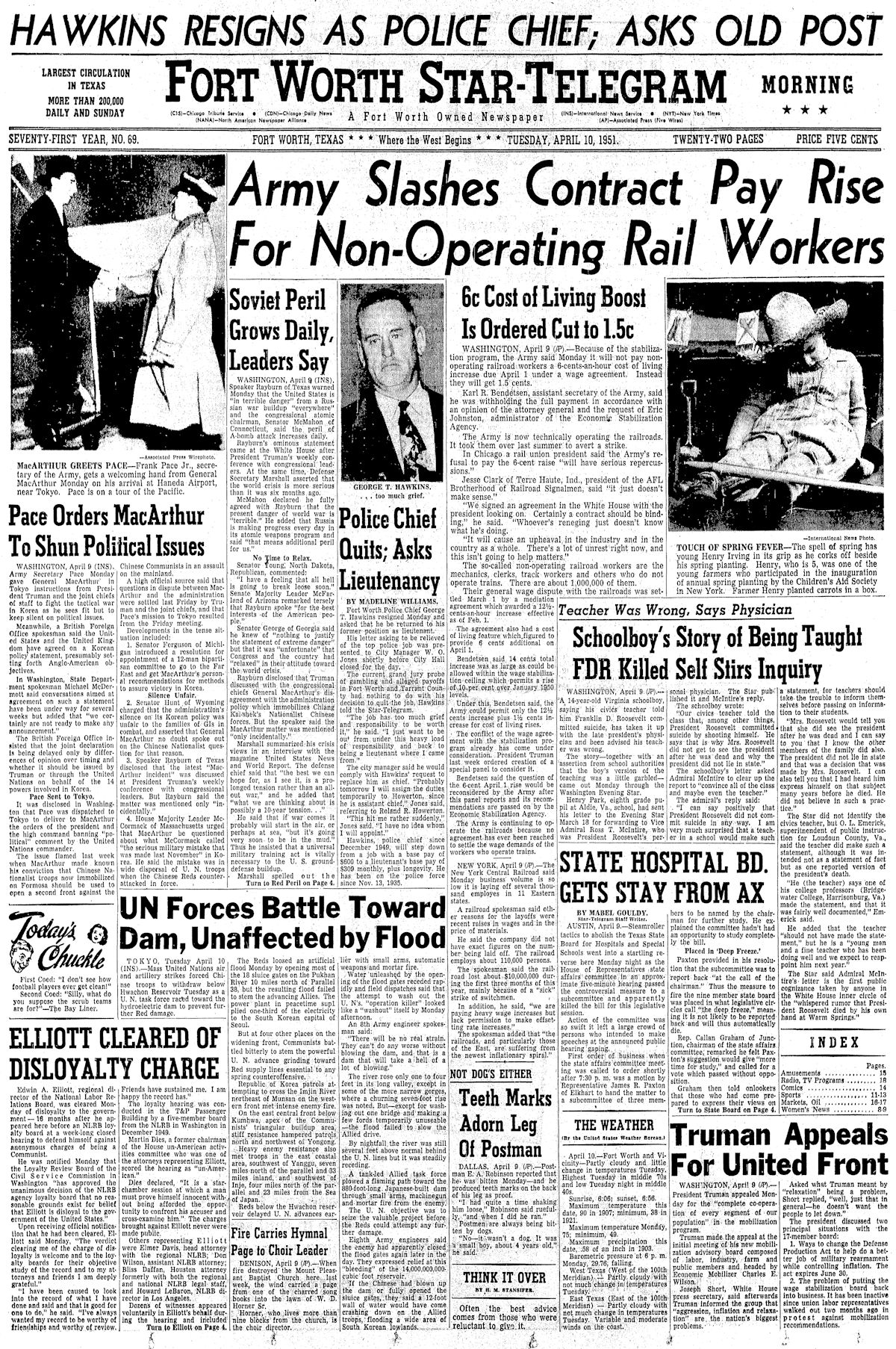 No police officers were indicted, but Police Chief George T. Hawkins suddenly resigned and was transferred to the traffic bureau at his former rank of lieutenant. He had been suspected of accepting bribes. Hawkins said the grand jury investigation into gambling and alleged payoffs had nothing to do with his decision to resign.
No police officers were indicted, but Police Chief George T. Hawkins suddenly resigned and was transferred to the traffic bureau at his former rank of lieutenant. He had been suspected of accepting bribes. Hawkins said the grand jury investigation into gambling and alleged payoffs had nothing to do with his decision to resign.
Jacksboro Highway was big vice. Big vice breeds big money, and big money breeds big enemies. Author Ann Arnold, in her definitive Gamblers & Gangsters, wrote that between 1943 and 1959 nineteen gangland killings took place in Fort Worth. Most of the victims were habitués of the highway. No one was ever convicted of most of the killings, including the Harris murders.
Even as the broom made of last straws continued to sweep the highway after the Harris car-bombing, the killings went on. There were three in 1955 alone.
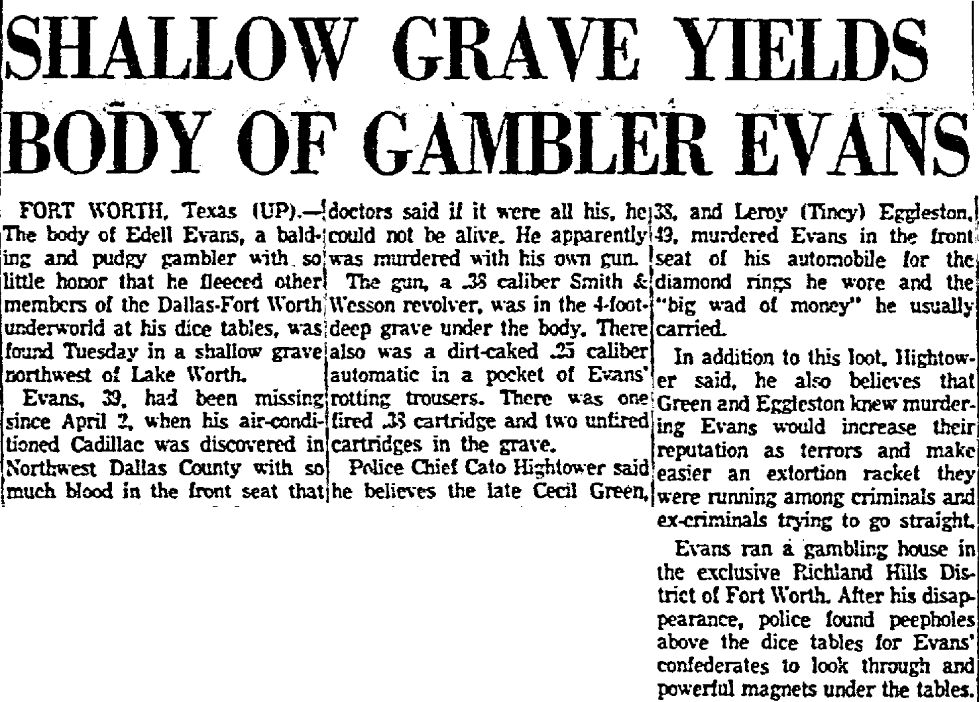 The first was Clifton Edell Evans. Evans ran a rigged gambling operation and a call-girl business. Police once found four thousand pairs of dice in a raid on his house. In April 1955 Evans disappeared. Police found blood on the front seat of his Cadillac. A few months later police, following a tip, found Evans’s body in a shallow grave not far from Jacksboro Highway. Police Chief Cato Hightower said highway gangsters Cecil Green and Leroy (“Tincy”) Eggleston, who ran an extortion racket, might have killed Evans to increase their reputation as men to be feared and not crossed. Clip is from the November 2, 1955 Dallas Morning News.
The first was Clifton Edell Evans. Evans ran a rigged gambling operation and a call-girl business. Police once found four thousand pairs of dice in a raid on his house. In April 1955 Evans disappeared. Police found blood on the front seat of his Cadillac. A few months later police, following a tip, found Evans’s body in a shallow grave not far from Jacksboro Highway. Police Chief Cato Hightower said highway gangsters Cecil Green and Leroy (“Tincy”) Eggleston, who ran an extortion racket, might have killed Evans to increase their reputation as men to be feared and not crossed. Clip is from the November 2, 1955 Dallas Morning News.
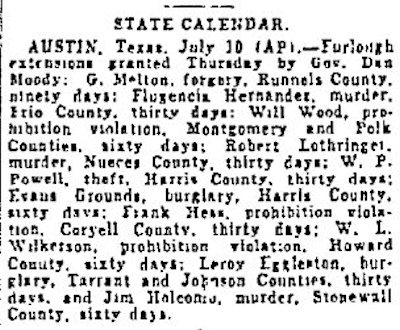 The second Highway to Hell killing of 1955 was Tincy Eggleston. Eggleston, born in 1909, was a gangster’s gangster. Beginning in 1926 he had devoted a solid quarter-century to local crime. Clip is from the July 11, 1930 Dallas Morning News.
The second Highway to Hell killing of 1955 was Tincy Eggleston. Eggleston, born in 1909, was a gangster’s gangster. Beginning in 1926 he had devoted a solid quarter-century to local crime. Clip is from the July 11, 1930 Dallas Morning News.
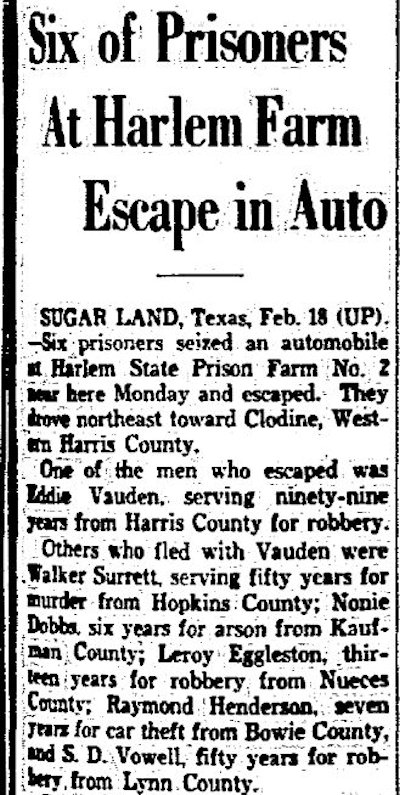 In 1935 Eggleston, serving thirteen years for robbery, had broken out of the Harlem state prison farm. Clip is from the February 19, 1935 Dallas Morning News.
In 1935 Eggleston, serving thirteen years for robbery, had broken out of the Harlem state prison farm. Clip is from the February 19, 1935 Dallas Morning News.
Associated Press writer Mike Cochran in 1988 quoted Cleon Nettles’s memory of the highway: “When someone got too big for his britches, he just disappeared . . . and they’d find him in a well.” And so it was for Eggleston, who ran a gambling operation on the highway in addition to the extortion racket with Cecil Green. In 1950, just hours after the Harris car-bombing, Eggleston had called police to report that he had just found a similar bomb in his car. Some insiders had suspected that Eggleston had killed the Harrises and then had rigged his own car with a bomb to divert suspicion.
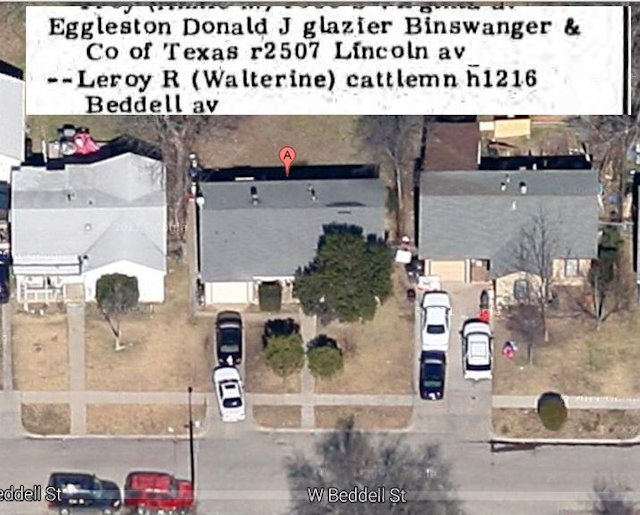 Eggleston was listed in the 1955 city directory as a “cattleman” living with wife Walterine in a modest house on Beddell Avenue on the South Side.
Eggleston was listed in the 1955 city directory as a “cattleman” living with wife Walterine in a modest house on Beddell Avenue on the South Side.
On a day in August 1955 Eggleston left Walterine and that modest house to meet an extortion victim for a payoff. The next day Eggleston’s bloodstained car was discovered.
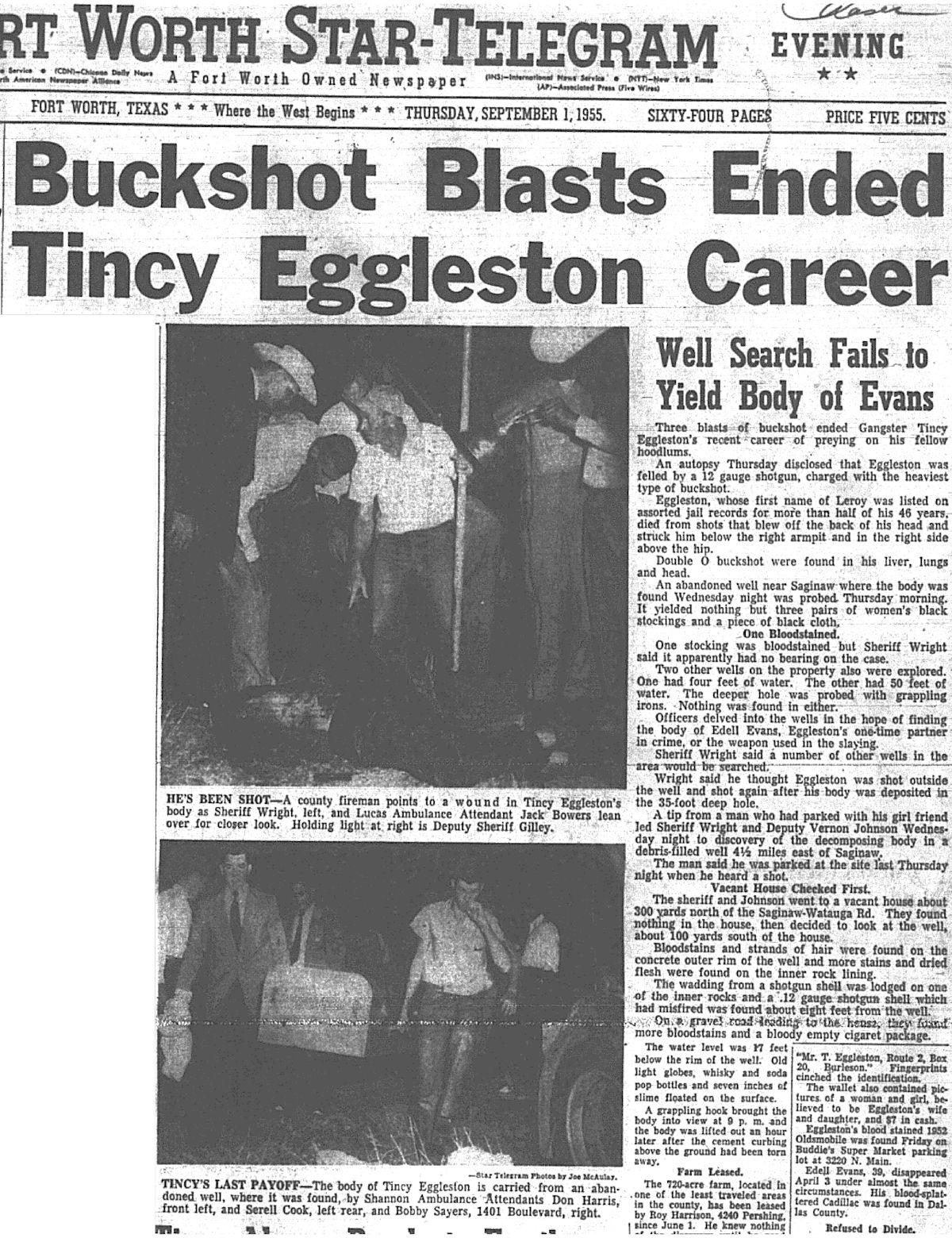 A few days later Eggleston’s body was found in an abandoned well east of the highway.
A few days later Eggleston’s body was found in an abandoned well east of the highway.
No one was ever tried for his murder. The highway’s gangland slayings were always front-page news at the Star-Telegram. Clip is from September 1, 1955.
 Frames from WBAP-TV news footage of the time show Eggleston, his bloodstained car, and the recovery of his body from the well.
Frames from WBAP-TV news footage of the time show Eggleston, his bloodstained car, and the recovery of his body from the well.
WBAP-TV news footage (no audio):
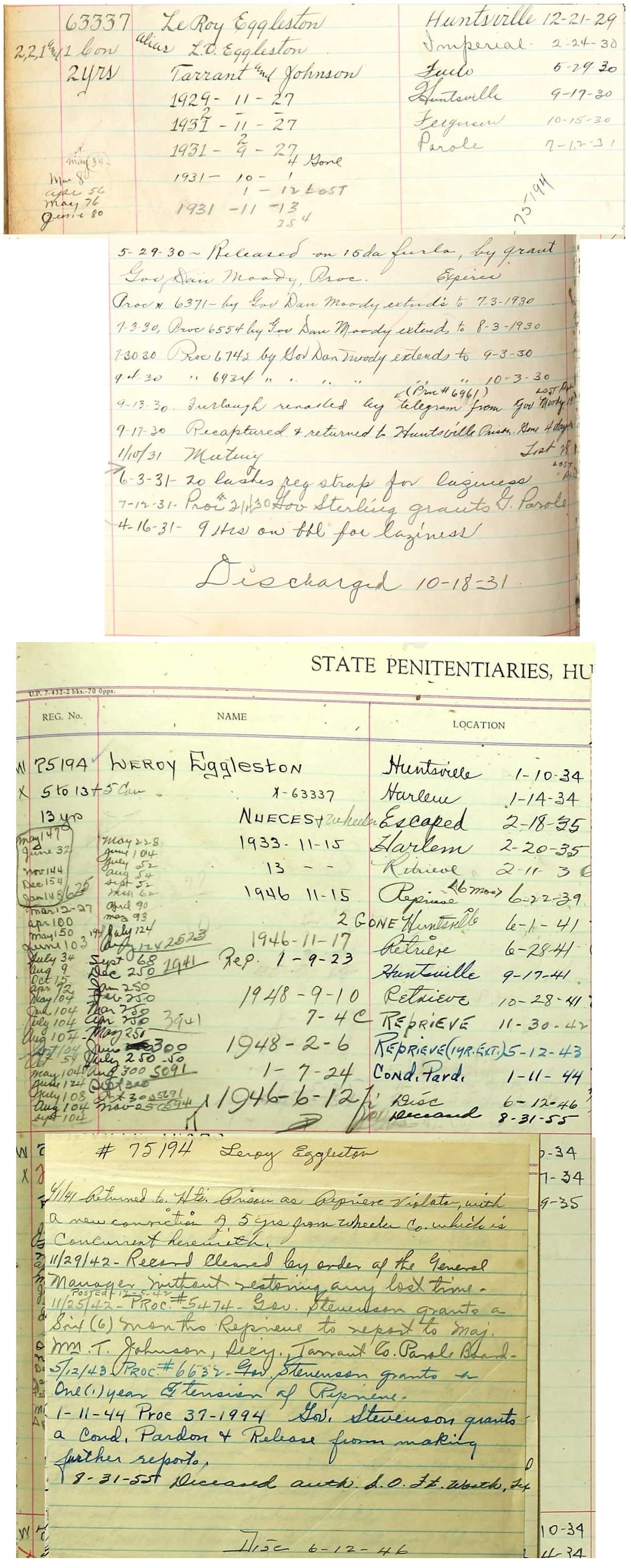 Considering how much time Tincy Eggleston spent touring Texas prisons, it’s a wonder he managed to work so much crime into his short life.
Considering how much time Tincy Eggleston spent touring Texas prisons, it’s a wonder he managed to work so much crime into his short life.
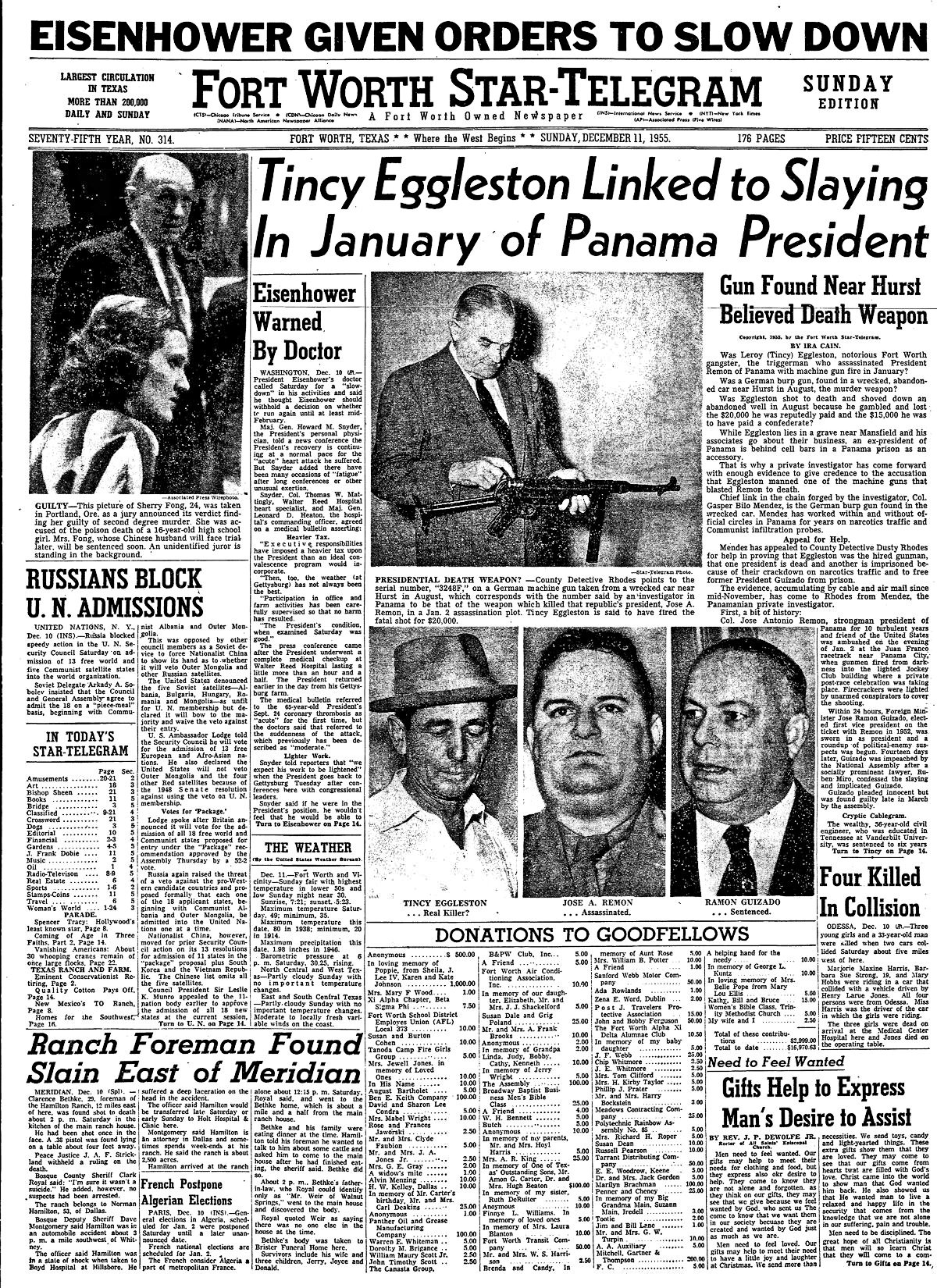 Tincy continued to make headlines even in death: The Star-Telegram in December 1955 reported that Eggleston may have been hired to assassinate Panama’s President Jose Remon after Remon cracked down on drug trafficking in Panama.
Tincy continued to make headlines even in death: The Star-Telegram in December 1955 reported that Eggleston may have been hired to assassinate Panama’s President Jose Remon after Remon cracked down on drug trafficking in Panama.
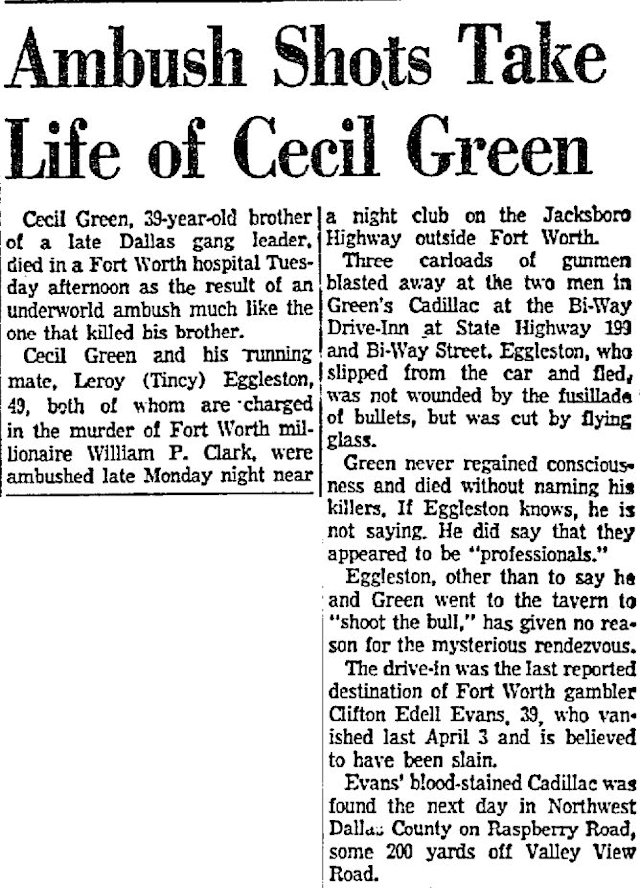
The third Highway to Hell killing of 1955 was Eggleston associate Cecil Green. Green also had been a suspect in the Harris car-bombing. On May 2, 1955 Green was gunned down as he sat in his Cadillac at the By-Way Drive Inn tavern on the highway. He died the next day. Police suspected that the hitman was Jacksboro Highway habitué Gene Paul Norris but could not prove it. (Norris’s sister, Dorothy Amyx, owned the tavern.) Eggleston and Green also were suspects in the William Clark murder case. Clip is from the May 4, 1955 Dallas Morning News.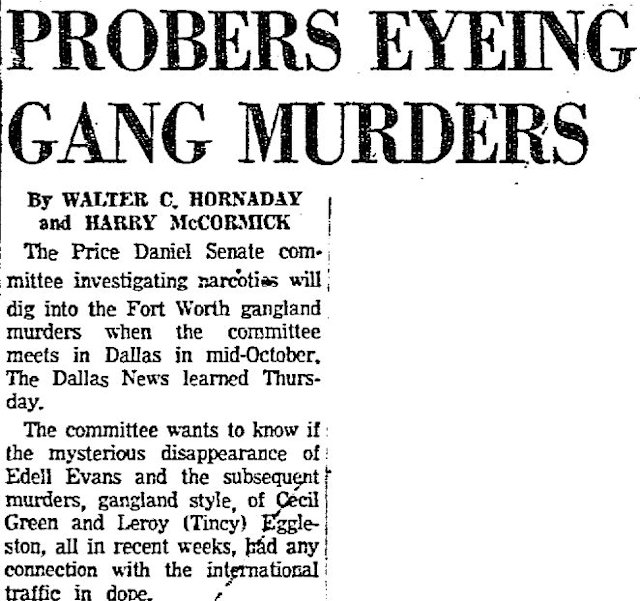
After these three Jacksboro Highway gangland killings in 1955, a Texas Senate committee investigating narcotics added Fort Worth’s underworld to its to-do list. Clip is from the September 2, 1955 Dallas Morning News.
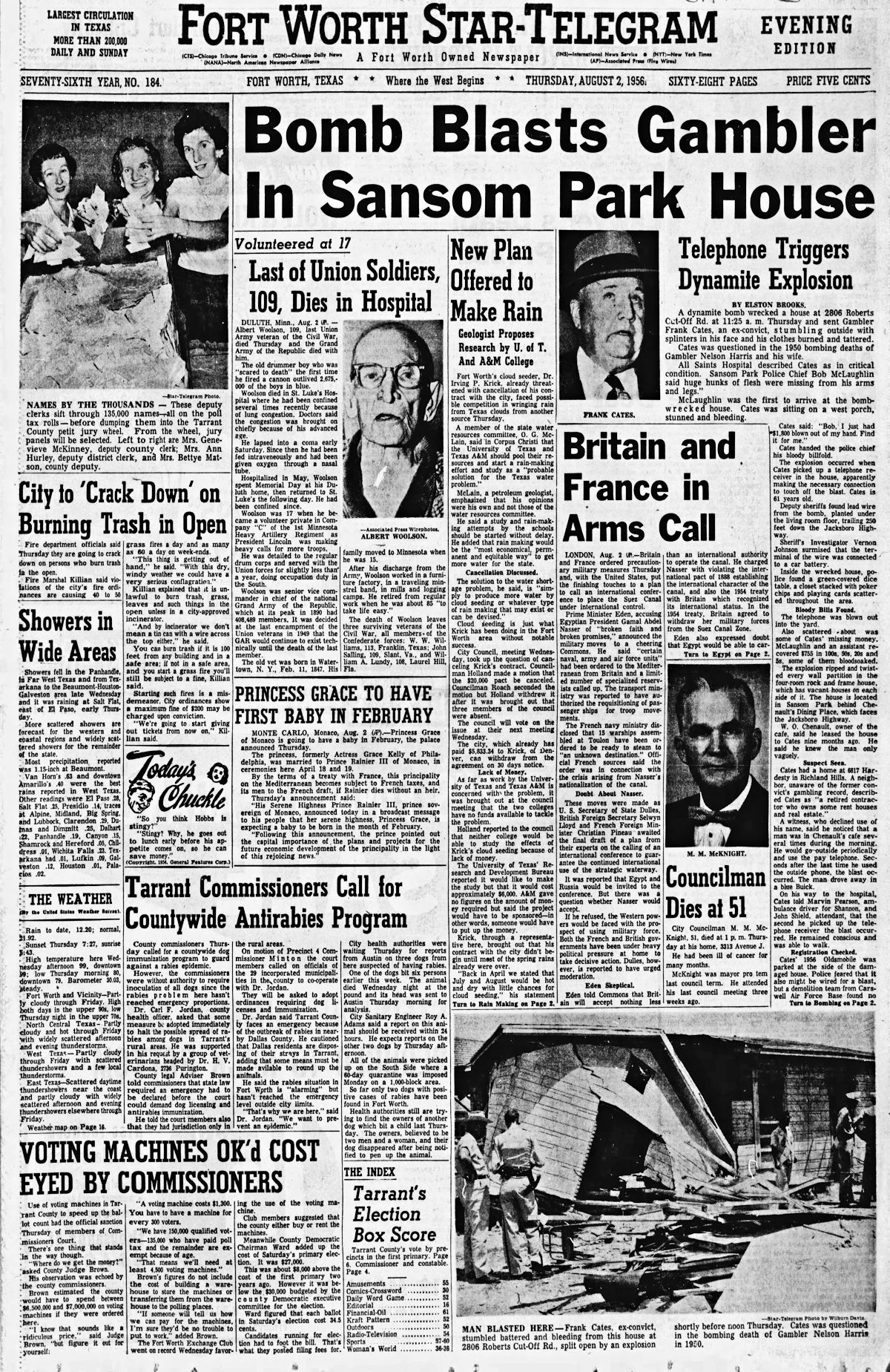 And the body count continued to rise. In 1956 gambler Charles Frank Cates, who had been questioned in the Harris car-bombing, was in a small gambling house he operated behind Chenault’s Dining Place on the highway. He was counting money when the phone rang. Cates picked up the receiver, and the house exploded. Under the house police found wires that ran 250 feet down Jacksboro Highway. Police suspected that one man had phoned Cates from a telephone on the highway—possibly from Chenault’s—and that another man in a car nearby had detonated the bomb when signaled by the first man.
And the body count continued to rise. In 1956 gambler Charles Frank Cates, who had been questioned in the Harris car-bombing, was in a small gambling house he operated behind Chenault’s Dining Place on the highway. He was counting money when the phone rang. Cates picked up the receiver, and the house exploded. Under the house police found wires that ran 250 feet down Jacksboro Highway. Police suspected that one man had phoned Cates from a telephone on the highway—possibly from Chenault’s—and that another man in a car nearby had detonated the bomb when signaled by the first man.
Cates survived.
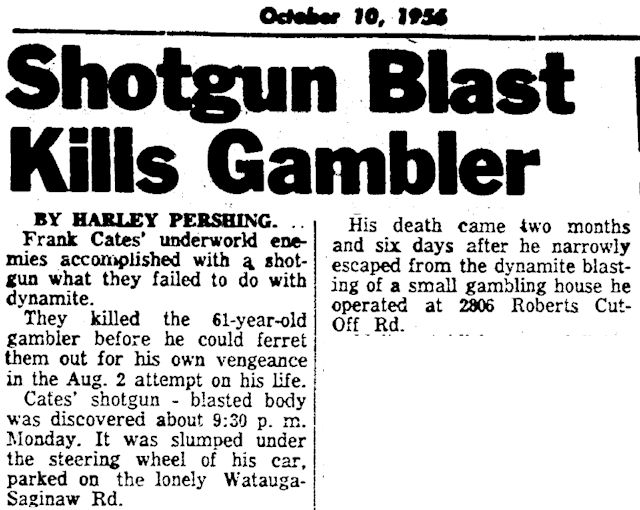 A few weeks later Cates heard his phone ring again. Tempting fate, he answered. Cates told his wife he had to go meet a man. Police found Cates’s shotgunned body in his car within a mile of the well that had yielded the body of Tincy Eggleston in 1955.
A few weeks later Cates heard his phone ring again. Tempting fate, he answered. Cates told his wife he had to go meet a man. Police found Cates’s shotgunned body in his car within a mile of the well that had yielded the body of Tincy Eggleston in 1955.
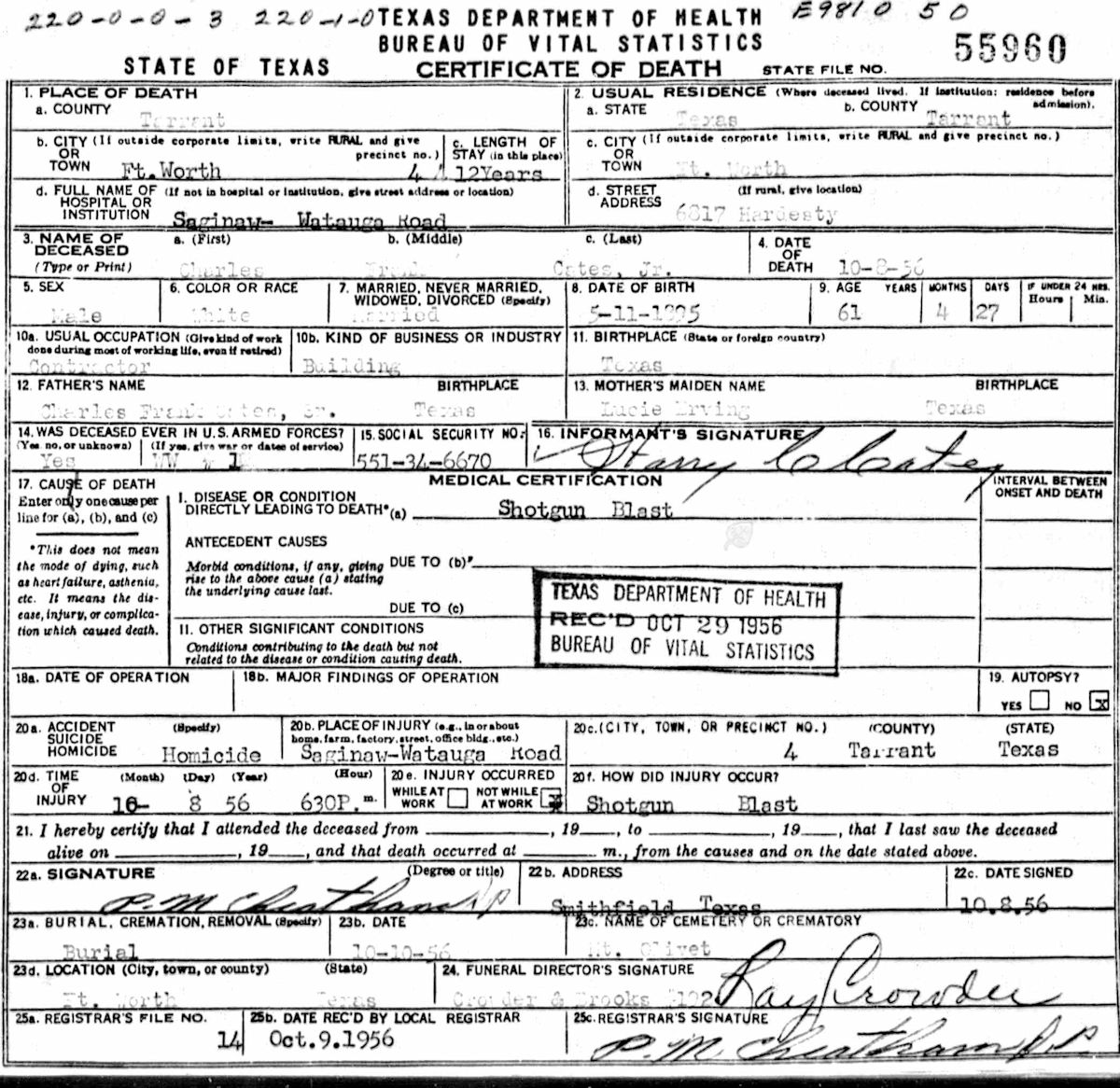 “Shotgun blast”: the death certificate of Charles Frank Cates.
“Shotgun blast”: the death certificate of Charles Frank Cates.
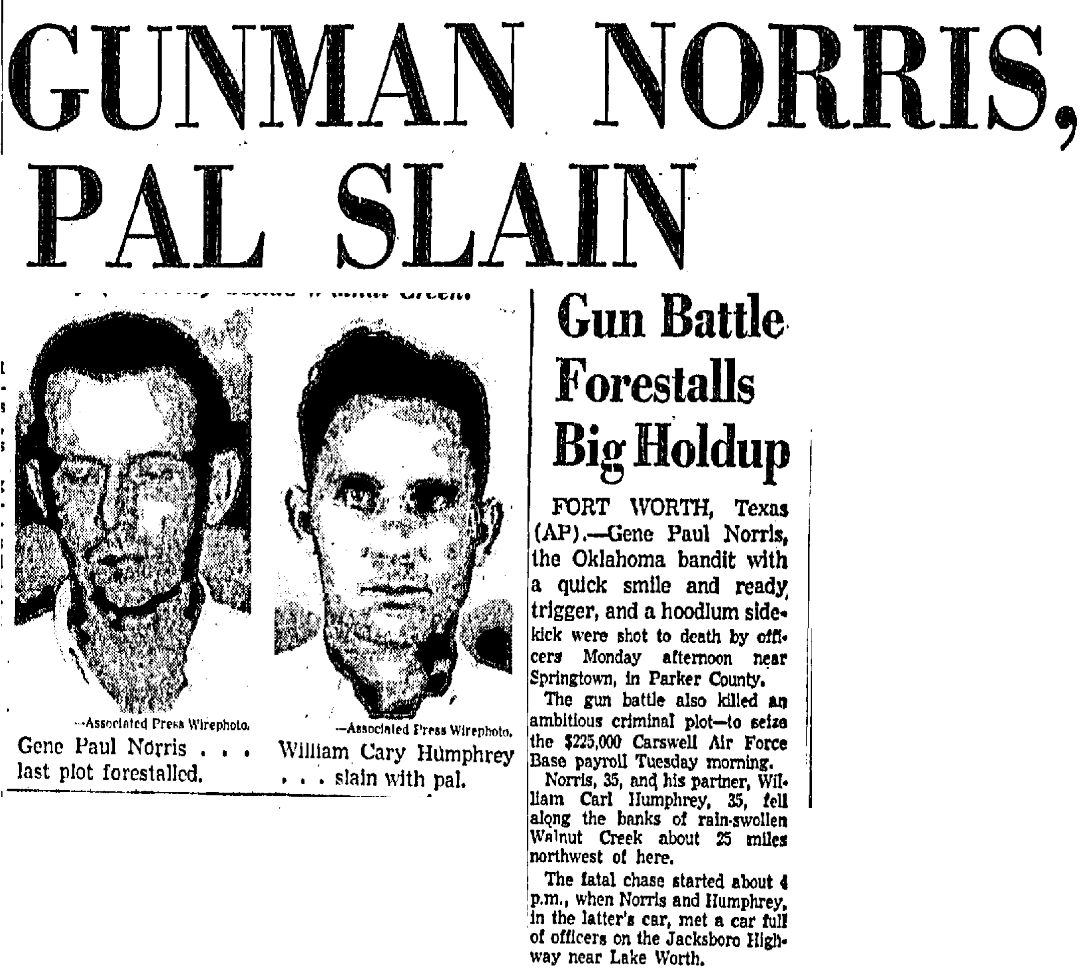 By 1957, as the broom of last straws continued to sweep the highway, Gene Paul Norris was on the FBI’s Ten Most Wanted list. And he had achieved that ranking before he planned the biggest crime of his career. Norris planned to rob a bank. But not just any bank. No. Norris planned to rob the branch of Fort Worth National Bank that was located in Carswell Air Force Base and held the base’s payroll of $225,000 ($1.8 million today). But police found out about the plan, and when Norris and his accomplice made a practice run along their escape route, police were waiting. Norris was killed in a shootout with police after a high-speed chase on—where else?—Jacksboro Highway. Clip is from the April 30, 1957 Dallas Morning News.
By 1957, as the broom of last straws continued to sweep the highway, Gene Paul Norris was on the FBI’s Ten Most Wanted list. And he had achieved that ranking before he planned the biggest crime of his career. Norris planned to rob a bank. But not just any bank. No. Norris planned to rob the branch of Fort Worth National Bank that was located in Carswell Air Force Base and held the base’s payroll of $225,000 ($1.8 million today). But police found out about the plan, and when Norris and his accomplice made a practice run along their escape route, police were waiting. Norris was killed in a shootout with police after a high-speed chase on—where else?—Jacksboro Highway. Clip is from the April 30, 1957 Dallas Morning News.
(In 1952 Gene Paul Norris also had taken part in the robbery of three Cubans at the Western Hills Hotel.)
Police Chief Cato Hightower said that with the death of Norris police could close the books on nine local murders, including those of Eggleston, Green, and Cates.
“He was a madman,” Hightower said of Norris. Clip is from the April 30 Star-Telegram.
After the 1951 grand jury named names, the IRS also became interested in business-as-usual on the highway. Gamblers and gangsters didn’t report their illegal income, of course. Likewise, city and county employees who were on the take didn’t report their bribes. But they often spent far more than the income they did report. That discrepancy interested investigators. Some gamblers were convicted of tax evasion.
By the time Gene Paul Norris was killed in 1957—seven years after the Harris car-bombing—the highway was reaching the end of the road. The world—big and small—was changing. In the big world, the postwar economic boom gave people less motive to gamble to get rich quick, to take a chance on repercussions, legal and otherwise. In the small world, the crackdown on vice on Jacksboro Highway was putting an end to business-as-usual. Many of the Mr. Bigs had been killed or jailed. And the highway’s high-rollers now had an option: They could pack up deck and dice and move to Las Vegas.
Finally came a public works project: Jacksboro Highway was widened. The city, invoking eminent domain, removed with a bulldozer what had not already been removed by indictment, bullet, or bomb.
Now the nightclubs and casinos of the highway are gone.
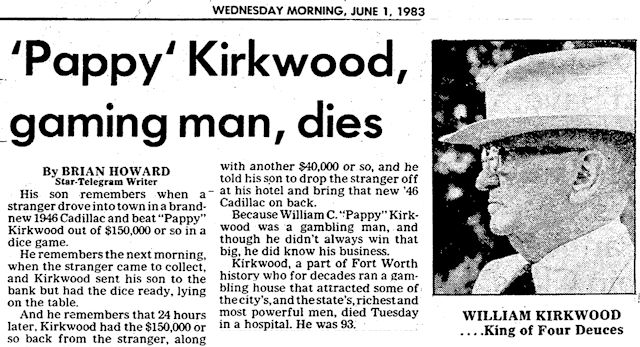 And in 1983 one of the most-storied names along the Highway to Hell died.
And in 1983 one of the most-storied names along the Highway to Hell died.
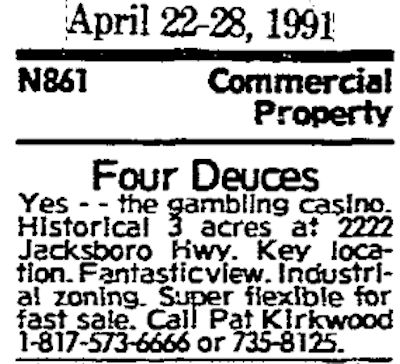 Eight years later the fabled Four Deuces itself crapped out. In 1991 Pat Kirkwood ran this classified ad in the Star-Telegram.
Eight years later the fabled Four Deuces itself crapped out. In 1991 Pat Kirkwood ran this classified ad in the Star-Telegram.
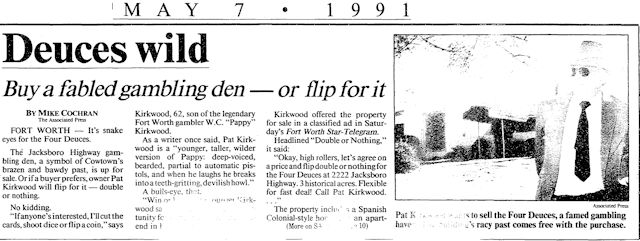 A month later, in a move that surely would have made Pappy smile, Pat Kirkwood sweetened the pot. He amended his ad: “Okay, high rollers, let’s agree on a price and flip double or nothing for the Four Deuces.” Alas, the Four Deuces was demolished despite attempts to preserve it for its historical and architectural significance.
A month later, in a move that surely would have made Pappy smile, Pat Kirkwood sweetened the pot. He amended his ad: “Okay, high rollers, let’s agree on a price and flip double or nothing for the Four Deuces.” Alas, the Four Deuces was demolished despite attempts to preserve it for its historical and architectural significance.
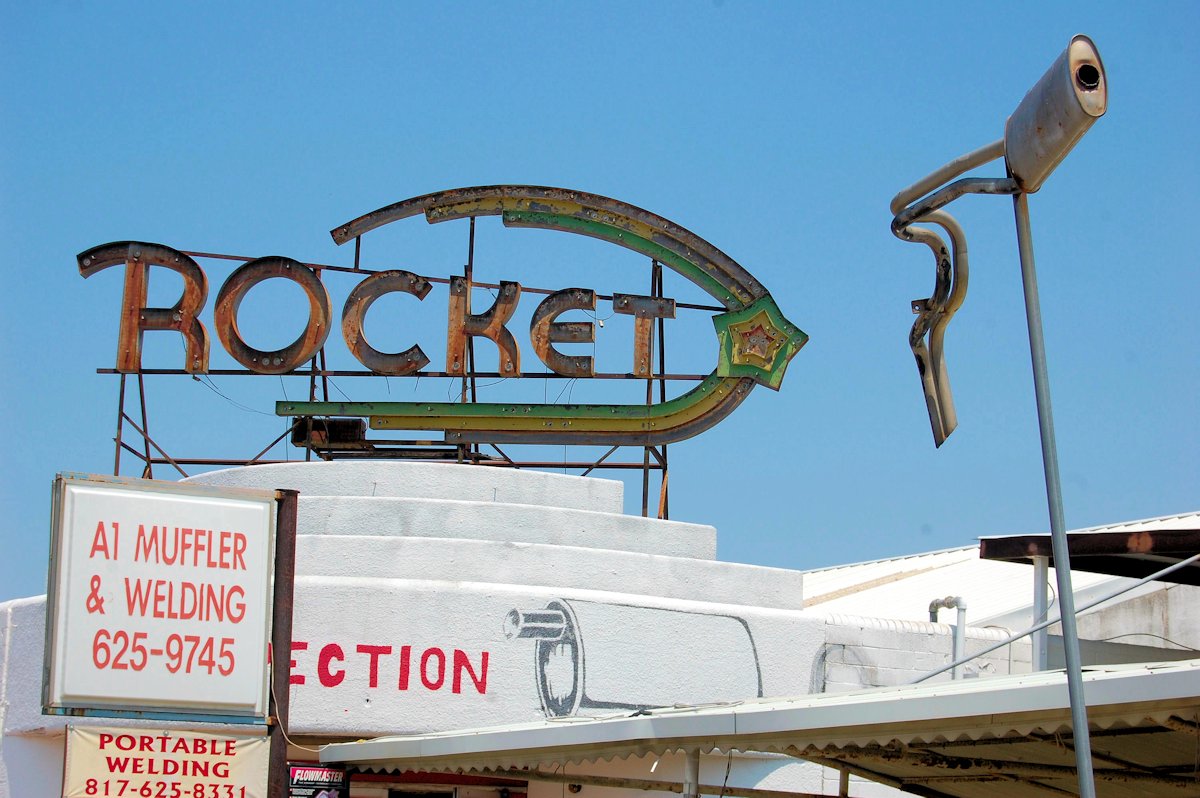 A survivor on the highway is the Rocket Club building. The building, with its canvas roof that retracted over the dance floor so couples could dance under the stars, was converted into a muffler and welding shop.
A survivor on the highway is the Rocket Club building. The building, with its canvas roof that retracted over the dance floor so couples could dance under the stars, was converted into a muffler and welding shop.
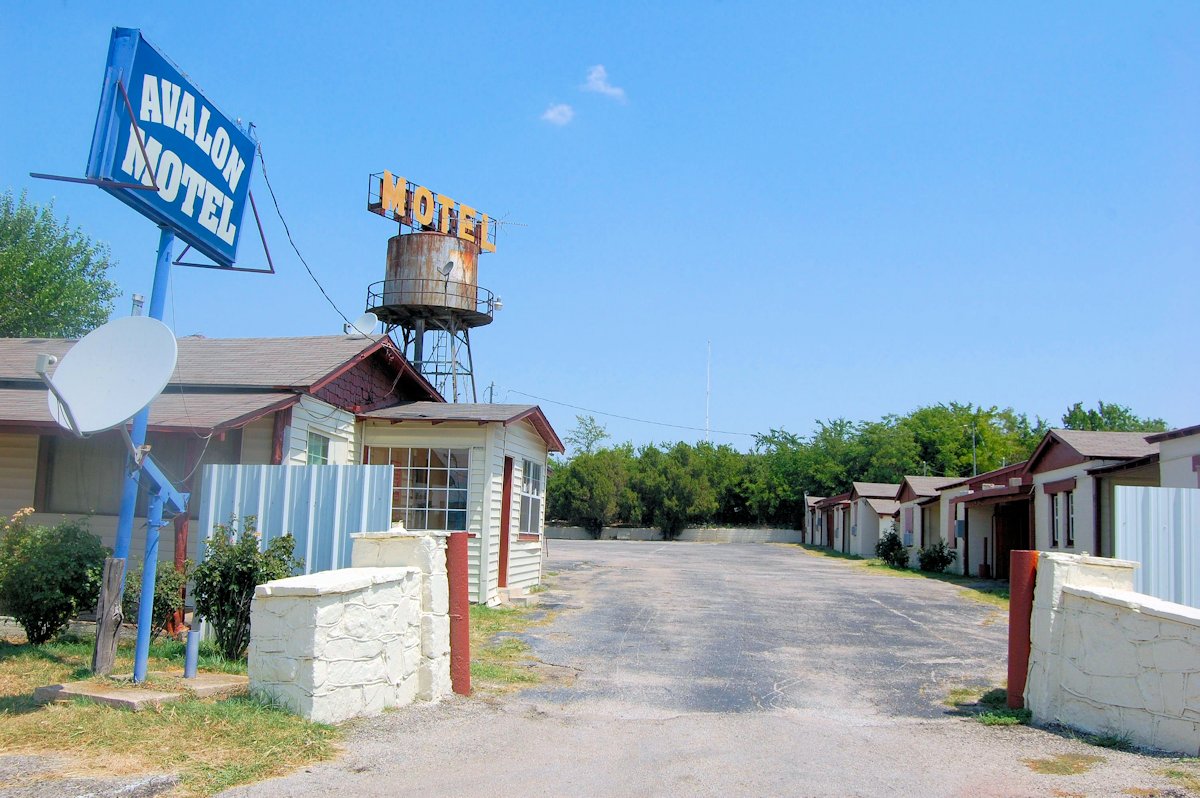 One block north is the Avalon Motor Court, once owned by gangster Asher Rone, who also owned the Black Cat Café next door. Gangster Elmer Sharp, who worked for Rone, once interrupted an assignation with a waitress at the Avalon to run next door in his boxer shorts to beat up four men who were robbing Rone.
One block north is the Avalon Motor Court, once owned by gangster Asher Rone, who also owned the Black Cat Café next door. Gangster Elmer Sharp, who worked for Rone, once interrupted an assignation with a waitress at the Avalon to run next door in his boxer shorts to beat up four men who were robbing Rone.
The Avalon survives as a respectable motel.
Today the Highway to Hell is the highway to fast-food outlets, small used car lots, propane distributors, and other small, decidedly prosaic businesses. For example, now located at 5811 Jacksboro Highway, just a block from where bored Elmer Sharp wrestled his pet bear at 5717, is an establishment that would have thrived on the Highway to Hell in the 1950s:
 Fort Worth Monument Company, crafter of quality tombstones.
Fort Worth Monument Company, crafter of quality tombstones.
A sampler of tombstones from the Highway to Hell:

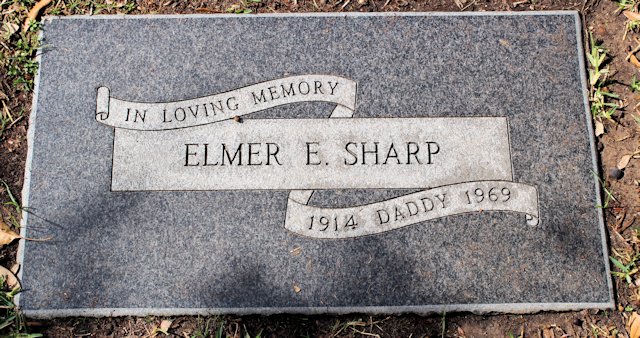 (The above photos from Find A Grave.)
(The above photos from Find A Grave.)
 William Calvin “Pappy” Kirkwood is buried in Greenwood Cemetery.
William Calvin “Pappy” Kirkwood is buried in Greenwood Cemetery.






Grew up on Chestnut Street in Northside by 21st Street. This information is amazing. I never knew JBH had all this history.
Hey i knoe this is a old thread but i was wondering if you have more info on the clubs/casinos on jacksboro highway like the rocket club and the 2222 club and maybe even footage? Im studying the mob and gambling history of fort worth from the 30s/50s
Guero, my blog posts on the Highway and its habitues include about all I know. The Ann Arnold book is the best resource. WBAP-TV news film footage might be found at the Portal to Texas History. Good luck.
Any way to buy this book?
If you are referring to Ann Arnold’s book, it is available on Amazon. So is Lost Fort Worth, but all the information in the book is in the blog.
Pingback: Fights in Fort Worth when JFK was shot: “A white guy ... said ‘I’m glad he’s dead.’ ” - Technical Earn
Hi,
Do you have any information on the man and his girlfriend who witnessed Tincy’s body being thrown in the well? I have reason to believe I know who she was.
Thx,
John
No, the Star-Telegram did not identify the “man” who “was parked at the site last Thursday night when he heard a shot” or his “girl friend.”
Thanks — my mom always told me that she left Ft Worth because she witnessed what she called a “gang murder”. We had to flee Ft Worth and went to Houston, which I can categorically say was not much better.
I never thought anything of this until this weekend while visiting my aunt who said to me, “Did your mom ever tell you about the time she was beaten to within an inch of her life?” No. She said, “When I saw her she was covered in gauze and casts from head to toe.” She added, “She saw a murder and men dumping the body in a well.” I asked my aunt when that happened and she told me when she was in Jr. High, eighth grade, 1955. Mom never said she was beaten, she only said she had to run for her life. I didn’t know anything about any of this until I looked up 1955 murder Ft Worth body dumped in well and this site came up. You can’t begin to imagine my surprise.
Hi John,
I’m doing research on Tincy and would love to talk to you about it. You can reach me at angela@enterprising-people.com
Thanks!
Did you know that Tincy’s grandson, Lanny B——, is in prison for rape and cutting the thumb off of a woman in Watauga. His mother Carol Baker, managed the Ramada Inn in Haltom City. He is the reason we now have stalking laws in Texas.
Did not know that. I have redacted surname until I can confirm independently.
Hello
I’m Thomas from Belgium and was able to acquire (estate sale) a casino chip set from The Chateau (5409 Jacksboro Highway). Looking for all additional information regarding this casino.
Thanks for this awsome and unique reference / source regarding Jacksboro Highway
Thanks, Tom. I have e-mailed you what little I know.
I would love the name of the book that tells all about the criminal doings in Ft Worth.
Ann Arnold’s Gamblers & Gangsters is mentioned in the post.
It was actually my father, Deputy Sheriff Dial Stone, who found Tincy Eggleston’s body in the well by following Tincy’s dog to the well. My dad and his usual partner, Vernon Johnson, went to to question Tincy’s girlfriend and “borrowed” the dog to take the area where he was suspected of having been killed. I have a photograph of the crime scene with Sheriff Wright, Vernon Johnson, and my father standing by the well during the recovery of the body.
Hi Rick,
I’m doing research on Tincy and would love to talk to you about it. You can reach me at angela@enterprising-people.com
Thanks!
Very interesting.
Thanks, Sally.
Good read. My father, Johnny Strawn, was a country musician in Fort Worth back in the 50s and 60s. He owned the Sunset Ballroom in 1954-56. I believe it was on Roberts Cutoff or Jacksboro Highway. Do you have any information on the Sunset?
Thanks, Phil. The Sunset Ballroom opened in 1952 in the building that formerly housed the Hilarity Club. In 1953 Strawn and three others bought the club. Bob Wills and the Texas Playboys played there that year. Also Hank Thompson. KXOL radio broadcast from the club in 1953. Lefty Frizzell and Billy Walker played in 1954. By late 1954 the building housed the Light House Club. Building was at 3100 Roberts Cut-Off one block north of the highway.
Hi Phil,
I’m doing research on the Jacksboro Hwy for a project I’m doing and would love to talk to you about it. You can reach me at angela@enterprising-people.com
Thanks!
Here’s an excerpt from The Last Waltz, The Band’s farewell concert movie, where Robbie Robertson talks about playing in Fort Worth. I think his info is wrong, but apparently they played at the Skyliner Ballroom. Robbie said it was owned by Jack Ruby, but we all know that’s not true!
https://youtu.be/S6hDCT0brQA?t=115
Excellent! Thanks for the link. Yeah, no way Ruby coulda done all the things attributed to him. But I DO have a photo of him with Cowtown’s Bobby Peters.
Howdy, are you aware if Asher Rone was related to a Cy Rone, who owned a couple of funeral homes? Thought they were in Azle and Boyd. Cy was known to my dad and I met him as a kid.
Roger, a quick check of Ancestry.com shows that Asher was born in Kentucky. Cy was born and raised in Wise County, later was mayor of Azle. Jim Wright called him “the mayor of mayors.” So far I have not found a relationship between the two men.
Hello! I’ve enjoyed reading your missives about Fort Worth. I’ve been trying to delve into Fort Worth history, and have been particularly interested in this early 1950s period, and Jacksboro Highway. I was curious – do you know if Black establishments existed out on Jacksboro highway, or were they confined to the Black part of Fort Worth? Do you know if there were any notable Black gambling halls?
I’ve read most of your posts on this topic and read Gamblers and Gangsters, and couldn’t find anything. Any direction would be appreciated.
Thanks, Katie. I am not aware of any African-American establishments on the Highway. My guess is that most were east of downtown. Also check Dr. Richard Selcer’s book on African-American history in Fort Worth.
Was a man by the name of Marshall Thomas Cotton part of the JHW group? Or later?
Ah, that’s a good multipart name to run through the “R&I” of the online newspaper archives. But all I find are stories about him being a shooting victim in 1978.
My dad and his “Little Rascals” group of kids were recruited by Tincy Eggleston to round up Horned Frogs to sell in New York…or so the story went. He would pay them a few cents for each one!
Boy howdy, I never heard THAT one. Ol’ Tincy was diversified.
Great stories Mike. Amazing you found all their headstones too.
Thanks, Keith. Interesting that so many of “our” hoodlums are buried “back home,” not in Fort Worth.
hi, my name is jack hodge. jack padgett was my great grandfather, he owned jacks place on old mansfield highway. i was always told he built it with money he made bootlegging. i asked my grandmother why another website(https://web.archive.org/web/20161206040016/http://foresthilltx.org/Docs_downloads/about/Forest%20Hill%20history_start%20to%20March%202016.pdf)
said his club was burned down in connection with arson and organized crime. my grandmother told me the man who bought the club from him was found in lake worth, with concrete to weigh down his body.
im trying to build a family history and find some pictures of the club before it burned down. do you have any direction you could point me in as to sources that would have pictures of the club? im thinking old newspapers might have photos of it after it burned down, but im new to researching this stuff. any help you could offer would be greatly appreciated
Jack, I have e-mailed you the little I could find. Good luck.
Do you still ride your bike around Ft. Worth and take pictures of places with historical significance and then add new information to your blog?
Dan, I bike every day, but if a photo I need is more than 15 miles from my home in southwest FW round trip (e.g., Top o’ Hill Terrace, the helium plant, Calloway Lake), I use a combination of pickup and bicycle.
Thanks for the information. My parents are moving into the Westmore Senior Living. He was from Riveroaks and the Northside and loves to talk about his youth. They have lived in Tyler for the past 20 years and decided it was time to come home to be closer to family. I look forward to exploring his old haunts with him. Your blog is spectacular. I know he will spend hours reading about the places you have chronicled. I have ordered your book.
Thanks, Dan. I’ll reach my one-thousandth post in a few days, but Fort Worth still amazes me with its history.
I’ve just found your blog, fascinating! Can you help me find more information about Hell’s Half Acre? I’m looking for images from the 1930’s through the early ’60’s before it was demolished. My dad spent his teenage years living between home (Riveroaks) and downtowns’s HHA’s cheap hotels. There are a number of articles about the area but much of the information centers around the late 1800 and early 1900’s notable personalities. Any information would be helpful. Thank you.
Thanks, Dan.
Most of my research on the Acre covers the active era. By 1930 the area was referred to in newspapers as the “former Acre” or the “old Acre” and not much written about or photographed.
https://hometownbyhandlebar.com/?p=18842 shows a few buildings still there in 1928.
https://hometownbyhandlebar.com/?p=28348 shows a few buildings still there in 1932.
http://www.hometownbyhandlebar.com/?p=13909 is about the Majestic Theater, one of the most prominent buildings in the area taken by the convention center.
http://hometownbyhandlebar.com/?p=24535 is about the Brown Building at the southern end of the old Acre.
This website might have something: http://www.fortwortharchitecture.com/oldftw/oldftw.htm
I know it was 65, cause I was a 9t grade, and I would turn 15
That Oct65…and go to Heights.
On April 29 1957 I was a 16 year old hanging out on the square in Springtown when the ambulance left town with all the lights on. Several of us followed the ambulance east on hwy 199 toward Fort Worth, Norris and Humphrey had turned off the highway on to a dirt road where they failed to make a curve. The 1957 Chevrolet was in the ditch and they were laying on the bank just across the creek.
I’m reasonably the victim was James Clyde Parrish; date was March 20, 1965. My recollection is the bombing was at intersection of Park Place and Forest Park Blvd. I never heard why the 42-year-old Parrish was killed–or why.
Yeah, James “Chock” Parrish. I e-mailed Randall the front-page story on the car-bombing. I limited my post to the pre-1960s era.
Choc was killed about the time the Texas Mafia moved in and started taking over the vending machine companies. Possibly connected but he had been involved with the other characters of the time, possibly a gambling or drug deal gone bad.
There is a separate post on Parrish.
Does anyone remember a murder in the lobby of the Ramada Inn in Haltom City in the 60’s – sometime known as the last gangland killing in Fort Worth? Looking for old newspaper articles, etc.
Randall Word, I have e-mailed you some clips on the killing of Robert Maclin in 1965 and on the car-bombing of James Parrish in 1965.
Did you ever hear of a shootout on Arch St., 8/20/58? Bobby Ray Foote died in his mother’s arms.Garrett Ramsey and Donald Gauntt were arrested in the murder, which was linked to control of prostitution in FW. Ramsey went on to have a colorful career as a “police character”. When he died at 71 in 2005, Bud Kennedy wrote a column about him. The title was,”Once feared, old gangster died alone and penniless.”
Was not aware of this one. Bud doesn’t miss a thing. For Cowtown the 1950s were the wild West revisited. Just a lot more horsepower.
Scott Tindall, are you kin to Louis Tindall?
I had never heard of James parrish but it inspired me to look and I found this: https://digital.library.unt.edu/ark:/67531/metadc975521/?q=james%20parrish%20murder
I looked into the Parrish story for a reader who lived near that intersection. Banner story of the March 21, 1965 Star-Telegram:
Gangland-Style Bomb
Kills Ex-Police Officer
DA Sees
Mobsters
at Work
Blast Rips Car
at Intersection
Below was a five-column photo of the bombed car. What a waste of a perfectly good ’57 Chevy.
Mike,
Hadn’t seen “Hometown” in ages. Glad to see it back in business (if it was out). I might have told you that I was present when they pulled Tincy Eggleston’s body from the well (worst smell I ever encountered). I think my dad shot the WBAP footage you posted.
-pv
Thanks, Phil. No, I did not know you were an eye (and nose) witness at the well. I looked for you in the footage, but no definite sighting.
Hi Phil,
I’m doing research on Tincy and would love to talk to you about it. You can reach me at angela@enterprising-people.com
Thanks!
My dad Ralph Claybrook owned a joint or two on Jacksboro HWY. He was killed in 1956.
I recall many of thse individuals, the history of jacksboro hwy is how i recall as a young boy who was raised in The Tom Cat Bar,later Known as The Cherokee Lounge on jacksboro hwy across the LW Bridge, just before th Rusty Inn.My Family left for England in 1955. ????
I’m gene Paul Davis my mothers father my grandfather was gene Paul norris
Nelson Harris was my uncle,my Dad Jay Harris was the oldest of four boys Ray and Austin Harris. Uncle Nelson gave me a job at the Skyliner Club in 1949 and 50 washing dishes.
Hi Tommy,
I’m doing research on Tincy and would love to talk to you about it. You can reach me at angela@enterprising-people.com
Thanks!
Hi Tommy,
I’m doing research on the Jacksboro Hwyand all of the killings and bombings. I would love to get your recollections of the time. You can reach me at angela@enterprising-people.com
Thanks!
I own property adjacent to Greenway Park, enjoyed the information and pictures you had back when there was no I35.
Thank You, Scott
Thank you, Mr. Tindall. I enjoyed learning everything that little park led me to discover about Fort Worth.
Hi Scott,
I’m doing research on the Jacksboro Hwyand all of the killings and bombings. I would love to get your recollections of the time. You can reach me at angela@enterprising-people.com
Thanks!
I remember that! (The James Parrish bombing) . . In fact I was there! I was in my grandmothers car and we were traveling north on Forest Park and were about 4-5 cars behind the car that exploded. I was only 6 at the time but I never forgot it. I can still remember seeing a hubcap flying up past a telephone pole.
Great story Mike. I think if I’m not mistaken Pat Kirkwood ran “The Cellar” in downtown Fort Worth. And how in the world did you find where these guys were buried at?
Thanks, Keith. Yeah, the Cellar was Pat’s Four Deuces. I could not have found those tombstones without knowing a date of death, which I did for the ones who died in the news. But Elmer Sharp had stumped me until just today when I was re-motivated to look for him. I found his obit, and that’s all I needed. So I have added him. Thanks for the nudge.
Carl’s bad tavern was the first place I saw a man beat to death in a fist fight there was no police report and as far as I could tel death on 199 was just a way of doing things, I would later be in a fight for my life with an angry drunk over a game of pool lucky for me I could scrap with the best of them
The period between my first year in Jr. Hi ’til A few years after I graduated from Hi School were VERY interestin’ years; because I had newspaper routes I was able to keep up with the details of the deaths. My Mother never quite got it; upon the demise of each “gangster”, she would state sumpin’ like, “well, that’s the last of them”, as if they committed suicide.
I know from family stories that my paternal grandfather owned the Hilarity Club and was the architect/builder of the Four Deuces. He owned another club, but I don’t know the name of it. My grandparents got divorced in the early ’40s. My dad died 2 years ago. I never met my grandfather because my dad didn’t get along with him.
The car bombing in the intersection of Forest Park Blvd and Park Place was earlier than 1960’s, because I was being taken to the Forest Park Pool by my Mom, and we came upon the bombing moments after it happened. I was not yet in high school @ Paschal when it happened.
Kathy Williams
Kathy, on March 20, 1965 ex-police officer James Parrish was traveling north on Forest Park Boulevard and waiting to turn west onto Park Place when he was killed by a “gangland style” car bombing. That is the only such incident at that intersection that I am familiar with, which does not mean there were not others.
In 1980 I rented an apartment at 2222 Jacksboro Hwy (Faye & WC Kirkwood ran it, Pat, wife & son were often there), once tickled him something fierce by bringing Dallas Times Herald Sunday magazine mentioned Hell Road (Jacksboro Highway).
WC would sit on stone wall in front of it and watch traffic go by, he told me many stories of what happened, who he had met, how he stopped playing cards when got a pacemaker because it would start making a noise if he had a good hand. He told me about his going out to Vegas to see Benny Binion, how he would stake you to bus fare back home if broke, but with the admonition DON’T COME BACK.
I was heartbroken when he passed away, I moved out in 1983 and never got back. Faye had some stories too, having worked with Gene Autry’s revue and competing and racing with Tad Lucas.
In fact if you wanted to see her dander up remind her how WC bet on Tad and lost, her voice would raise and she would loudly say was glad he lost the money shouldn’t have bet against her.
Willie Nelson got his start on Jacksboro Highway, playing in honkytonks on Saturday night and Metropolitan Baptist on Sunday mornings.
Milton Brown (of Milton Brown & His Brownies) lost his life on the Jacksboro Highway in an auto accident right across from Avalon motel.
It was a magical place, in many peoples memories. Now it looks nothing like it did even 30 years ago, sad to see so many places gone that shared those times.
Thanks for great article
I met him just once at a party at a house on the bluff overlooking the highway. If he did half what he claimed to have done, there is a book in Kirkwood.
Hi John,
I’m doing research on the Jacksboro Hwy int the 40’s & 50’s. I would love to hear some of the stories WC told you. You can reach me at angela@enterprising-people.com
Thanks!
No, definitely not the same man. Unless maybe he cleaned himself up afterwards. My grandfather Robert, who was his son was like night and day compared to him. My dad tells the stories of how men would come to George with wads of cash. I know he shot his wife at one point to. Robert was stabbed in a club though. My grandmother said that was all over the newspapers. I’m not going to lie though. If the stories of George turn out fabricated and he was a dachshund breeder, I’d probably die laughing. I’m also curious about Robert Plummer so if you find anything about him send me an email please. Thanks!
Great read! My family was involved in the going on of jacksboro highway. I don’t know much other than George Plummer raised pit bulls and fighting roosters. Have you ever heard of him in your research?
Thanks, Joseph. I did not come across that name in my research. Also don’t find it in Ann Arnold’s book. In the 1950s Dallas had a George Plummer who was a noted dachshund breeder (probably not the same man).
This is great. I want to send it to my good friend Mike
Cochran, but can’t figure out how to get it from FB to e-mail. Can you e-mail it to me, please.
Thanks, Susan. Mike and our mutual friend, the late Jerry Flemmons, are two of my writer heroes.
Enjoyed your history true stories. I lived on the East side when much of this happened. Tarrant county is still tough if you know where to go. Places when you can’t travel by foot or car!
Thanks, Marian.
Love reading anything that mentions the Coconut Grove off the Jacksboro Hwy just south of the Lake Worth bridge. I grew up behind the Coconut Grove. The rock building also housed a beauty shop owned by a relative Buelah Hodgkins. I used to play at the beauty shop & would sneak next door to see the daytime drinkers! My address was 7005 Edgemere which was eaten by the expansion of the Jacksboro Hwy. Leslie’s pit bar-b-q was on corner of Edgemere & Jacksboro Hwy for years. My dad’s family (Hodgkins) started the Lake Worth School. Love the history
The story of Elmer Sharp…wow…he had been to my grandparents’ home often…when I was maybe 14 and younger, he would say scratch my back little girl…and I will give you candy….I would have to do it…really gross…He was a very large man, but married to a very sweet woman Madel…and his Mother was called Big Mama…it’s wild to think about these folks…and all the times my family had spent with them.
Elmer Sharp was my cousin. His mother was my aunt my dad’s sister. My dad and Elmer were close to each other’s age and ran around together when they were teenagers. I use to spend the night at his house when he had the after hours club in his garage. I remember a lot about Elmer and my aunt Olie.
Great article I worked on the highway in the 70’s and it was still quite a rough place lots of bars all the way from Azle into town lots of colorful folks on 199 and never a dull moment still have a lot of old friends there memory lane lol
Thanks, Pat. Seems that everyone either remembers the highway or has heard stories about it.
I ran into Minnesota Fats. we talked for hours about the places up and down the hwy.He said he liked the 50-50 club the best. We talked about all of them. He named some clubs but would not talk about things that happened inside.
I ran into Minnesota Fats. we talked for hours about the places up and down the hwy.He said he liked the 50-50 club the best. we talked about all of them he named some clubs and would not talk about.
My dad owns 5717 Jacksboro Hwy and we knew it was not a typical house with a typical past when we first saw it after his purchase 30-something years ago. Any “garage” built of cinderblocks that never had a garage door but has a fire-branded wood ceiling and huge wagonwheel light fixture is a garage in name only. We spent so many days playing on the hill and wondering about the true use of the odd structures and modifications to the house. I would love any info on the property if you could forward. Thanks for a great read!
I live at 5717 Jacksboro Hwy, Fort Worth TEXAS 76114
And would like to no any info about the property!!
And the wood ceiling has all These stamped initials and letters and stuff double deuces and dice 666 on it I mean there’s a lot of stuff first burn into the salon. If anyone knows anything let me know cause I’m curious to know
Gambler Elmer Sharp lived at that address in the 1950s and 1960s.
Thank you for sharing. What a great read. My great grandparents settled in North Side. I have heard stories through the years about my PawPaw, Clifford Osborne Southard. How he was friends with Bob Wheels, bootlegging, ect. It would be fascinating to know more:) Thanks again for sharing.
Thanks, Sandi.
Does anyone know anything about the death of Neota Moad Green, married to Dude Green, lived in River Oaks, I think. Was tied up, shot in head. Put in closet, house set on fire. She had been a beautiful majorette at TCU, but unfortunately married into the Green gangster family. Her murder was never solved.
Gale, I have e-mailed you a clipping from 1963. Ronnie Blankenship was acquitted of her murder.
Yes, I knew and met Dude Green and the woman when I was a boy. remember the incident.
In or around 1964-65 v I was returning home from basketball practice at paschal high school one Saturday afternoon. My home was off forest park blvd on pembroke drive. One block east at forest park blvd and park place ave, a car was blown to pieces by a car bomb. Reportedly, this was the last gangland-type murder relating to JHW characters. I don’t remember who died nor much about the investigation. I have read the book about gangsters and gamblers. I loved it. I gave my copy to my friend Tim Curry (DA of Tarrant county for many years.) He later reciprocated by giving me a copy of a book about old courthouse characters or something such. As an aside, along through my years as a criminal defense attorney-much later on (1975-2014) I became acquainted with a man who was a bagman, collector, enforcer for Tincy Eggelston. He remains a source of great stories about those days.
I think that the individual who died in that bombing was “Chock” Parrish.
Parrish Inn was destroyed by a natural gas leak.
Thanks, Terrance. With a name to go on, I found this in newspapers of September 3, 1956:
Fire, Explosion Destroy Night Club in Fort Worth
FORT WORTH (UP)—An explosion and fire destroyed a Fort Worth nightclub early today and firemen and police started an investigation under the theory that it wasn’t accidental. Owner Bill Jenkins estimated the value of the ruined large frame and plaster building to be $100,000. The name of the nightclub had recently been changed from Parrish Inn to Paul’s Club. The explosion was a powerful one, knocking out plate glass windows in a next door liquor store and windows in surrounding houses. A two-by-four was blown through the window of one of the houses and a chair blew out of the roof of the club and landed straddled across high power lines. Investigators found a full five-gallon gasoline can in an adjacent vacant house. Neighbors said they heard a car speed away just before the explosion about 3:30 a.m. Petitions were being circulated in the neighborhood to close the club as a nuisance. The explosion was in the dance hall section of the club where there were no gas connections.
And this Channel 5 news script:
I don’t have access to the 1956 S-T and find nothing in the DMN of September 3.
Thanks for the response. I started going to the Parrish Inn when I was 19 and some of the folks above were frequently in attendance. We had been out of town for the NHRA drag races in Oklahoma City or Kansas City, don’t remember which, anyway driving by Sunday afternoon, that building was flattened.The only thing standing were some plumbing pipes. The explosion was not just the dance area, the entire building was gone. There were gas connections in the club for heating and hot water. Could be that there was a leak,or someone could have LEFT the gas on. Gasoline would have caused a fire, but not an explosion. Great site and I have many memories of beer joints, clubs, and other shady places in Ft. Worth. Tailless Monkey, Stellas, Party Line, Tropicana, Desert Lounge,Back Door, The Gables. These were all in Riverside. Also, while not hanging out in Riverside, I found time for Mansfield Hwy (Jack’s), Jacksboro Hwy(Rocket) and my favorite east side lounge the, Penguin Club.
There are still a few parts of those three strips that look unchanged. Love that old rock motor court on Belknap.
My Uncle Harold R Willis worked and owned a couple of Bars on Jacksboro Hwy in the 50’s and early 60’s I believe one such bar was Ricardo’s. I was too young to ask him about the stuff that went down at that time, but some how I knew he was right in the middle of it all.
I loved this! I grew up in Oakhurst, and remember going to a place to eat there. (Log Cabin maybe) My father and brother played Rockwood GC a lot. Thanks for all the research!
Thanks, Cheryl.
Nelson Harris was my great uncle!!!
Nelson Harris is my Great Uncle
I was born on the Northside on Roosevelt. We lived there until I was 5 years old. I loved living there and had friends I hated to leave. My dad had gotten to a point he could afford to move to the Southside. I remember years later being told that his major goal was moving us kids away from that area but never was told why. Just told Dad wanted us to live in a better place. Now I can understand why. Later in High School I went with some friends to the Skyliner and also in college. I know my dad would hate knowing I went there so I never told him. That was in the late 50’s and early 60’s. Such an interesting story! I love your blog. So fun to learn more about my native city.
Thanks, Anita. I was born three blocks from the Stockyards. I still don’t know how we ended up in Poly.
This was fascinating. I lived in Haltom City as a little girl in the early 50’s and remember “stories” of Jacksboro Hwy. I remember a bar we used to drive by near Sammie’s BBQ on Belknap, the Parish Inn (it had real saloon doors). I was fascinated by it because the building was pink. It was destroyed by a bomb sometime in the 50”s. Do you know the story??
Donnave, I don’t know that story. But that bombing does sound like it could be part of the gangland activity of the 1950s.
In high school we danced at the Rocket and the Skyliner. As I recall, it was the Skyliner that had the retractable roof.
Rick, I can’t vouch for the Skyliner, but I know the Rocket Club had a retractable roof. And its table pedestals were the rear axle housings of cars. Oh, the stories about that highway. I know a veterinarian who as a young man played piano at the Skyliner when Candy Barr was the headliner. Etc., etc.
sometime during the Fifties, there was an ambush shooting in my neighborhood. (Poly) As I recalled two men hid in a flowerbed of the house across the street from another house. When someone came out of the house in the wee hours of the morning they were shot. Don’t remember if any one died. I remember hearing the shots. The street it occurred on was Sandgate St. down from Spiller St. and Mitchell Blvd. Seems like I remember people saying it was a gangster hit related to the activities on Jacksboro Hwy.
Carey: Well, FINALLY the East Side gets in on the action! But seriously, I had not heard that story, but I grew up near that location (on Burton) and misspent much of my youth in nearby Cobb Park.
My Mother was a nightclub photo gopher in the 50’s and had her own dark room to develop pictures in the Skyliner club, as a small child my sister and I would check coats there, we have pictures of Candy Barr and I still remember all the clubs on Jacksboro Hyw. The Rocket club and The famous Massey club…my mom who now has Alzheimer’s but can still talk for hrs and recalls memories of her working the clubs on Jacksboro Hwy making a good living as a photo gopher. Really enjoyed this article
Thank you, Linda. Your mom had a fascinating job. I used a photo taken by a Rocket Club photographer in my book. The photographer was not identified.
My family lived in RO a stone throw away from the Hiway,we owned establishments on Eagle Mountain Lake and Lake Worth yet many of the gangsters” were known to frequent, born in 1960, I knew a different Elmer Sharpe, ” Uncle Elmer” as I called him was a kind gentle giant, who i loved dearly,spent many aday on that hill, funny how different the reality was.
My granddad Dick Wells was a well known gambler in those days, we’re just recently finding out about this, and that his mother owned some brothels in Corpus Christi.
my husbands grandma and grandpa had a life along the jacksboro hwy. His aunt Mary owned Mary’s Mistake and his grandma worked there her name was billy Nell Roper later I believe in the 70’s and his grandfathers name was William Roper. My family has a long history along jacksboro highway too this story brings back a lot of memories of stories my papa has shared with me. Thanks for taking the time to share this.
“Mary’s Mistake”! What a great name. Thanks, Whitney.
I’m related to the owners of the Double Bar Club and the managers in the 1950’s. The Double Bar Club has been replaced with an Ace Hardware Store,
WHERE ACE HARDWARE IS NOW, USE TO BE A CLUB CALLED” THE BACK ROOM”. HAD TUNNELS LEADING FROM CLUB TO IT’S RIGHT. IT WAS ALSO AT ONE TIME A GAY BAR. THAT SITE HAS A LOT OF HISTORY!. I WAS A POLICE OFFICER IN SANSOM PARK ( PATROL DIV ) WORKED MID TO 8:AM. THE HIGHWAY WAS WILD AND DANGEROUS. I LOVED MY JOB AND WAS THE FIRST FEMALE OFFICER TO WORK JBH. I LEFT IN EARLY 80’S. SAW MY SHARE OF THE EVIL, THE WILD AND RECKLESS!. LOVED THE JOB AND WOULD GO BACK AND DO IT ALL OVER AGAIN. FOREVER I WILL REMEMBER JACKSBORO HIGHWAY!.CARRIED SIX PAIRS OF HANDCUFFS ON TURN SIGNAL, MY SERVICE REVOLVER, BACKUP GUN IN ONE BOOT, SMALL GUN IN MY BRA, AND SWITCH BLADE IN MY OTHER BOOT!.
IT WAS A BUSY TOWN WITH LOTS OF ACTION. I DO REMEMBER “THE HIGHWAY TO HELL!”…
I grew up next door to Harry Beason, the first chief of police for Lake Worth. I pretty much grew up on stories of Jacksboro Highway. Fascinating times those days must have been.
i was wondering if anything about my great grandfather Boston Smith? He was in the Gangsters & Gamblers of Jacksboro Hwy? Thank you
Sorry, Courtney. I don’t have any information on Boston Smith. In the space I allotted for this story, I could give only an overview and touch on the headline-making events. That means that most people and places from that era had to be left out.
I would love to know more about your great grandfather. I have posted his house on “Back roads of Aledo” and “Fort Worth Pic Past and Present” on facebook about his house.
Did he have a brother named Charlie Smith?
i remember my dad running a club called The Western Village. Near Mom & Pops Buggy Wheel. Later he opened a club on Lake Worth called The Castle Club. We lived in the small rock houses next to the club. This was in the mid to late 50’s
I had an older sister that would take my brother and me up and down the JBH to Casino Ball Room ,Green Door, Skyline and Rocket.Later my older brother worked at Kirkwood’s The Cellar in downtown Ft. Worth my sister was married to Junior Sides and went to prison during the Hwy cleanup.
My uncle Chief Craig was a police reporter during this timeframe and when not in college during the summers I went with him on several investigations usually on Jacksboro Hwy. He always insisted that I stay in the car until he returned and then we went back to the basement of the old municipal building where he would post the story for the Star Telegram..I was on the “fringe” and usually read about the details the following day in the paper.
Sam, your uncle was my first boss on the city desk in the late 1960s and one of the nicest newspaper people I ever met. I always go by his grave when I am at Oakwood.
grew up hearing the name jacksboro hwy in relation to my cousin who played country music in clubs out there at least in the 60’s. never heard any details. just overheard conversations. I was born in 58 and didn’t know any of this from the article. lived in benbrook then later right off las vegas trail and the hwy. Very interesting. Saw a mention by a sam craig about chief craig and you indicated knowing him too. I have family named Craig and wondered if there is any relation. family from Comanche county area deleon/comanche. What was cheif craig’s first name? is the oakwood cememtery you mention in comanche?
Ms. Kurtz: I had to stop and think. He went by “Chief,” but his name was “Horace.” He and his parents are buried in Fort Worth’s Oakwood Cemetery.
A bit about the father: https://hometownbyhandlebar.com/?p=660. I don’t know more than that. Chief wrote a small book about the Stockyards.
Sam, I worked with your Uncle at Convair (now Lockheed )before he went to the Star Telegram. Nicest man I ever met, we called him the gentle gaint. Had lunch with him a couple of times after he left, and then kept up with him by reading what he wrote. Nice Guy. Jimmy Hix
My Mother’s maiden name is Cates. Wonder if there is a relation to the name on the grave stone.
The death certificate does not give much to go on. Named for his father, both born in Texas. Jr. born in 1895. Mother was Lucie Irving, born in Texas.
I really enjoyed this article. I have wondered how the wall along the highway came to be, and whether the homes that back up to JBH were involved in any of the activity along the highway.
My Mom worked on Jacksboro highway during all this. She worked at the Double Bar,Rocket Club,Inez’s and the Buggy Wheel. She passed away May 15,2014 but she would have enjoyed reading this piece.
Thanks, Linda. Wild times on the Highway.
Have you ever heard of Lynn’s? Bar on Jacksboro Highway. When I was a kid I was told it had a very colorful past.
Vicki, I have not heard of Lynn’s Bar and don’t find it in the 1957 or 1968 city directory, but from year to year businesses came and went out there, and most of them don’t get written about in stories about the Highway.
Lynns is further west on Jacksboro Hwy, closer to Azle. My grandparents ran up and down Jacksboro Highway, back in their haydays 🙂
Lynn’s is actually in Azle, TX. We had another old bar The Sawmill, that has been many things since then. Jackboro Hwy runs right through the middle of Azle.
[In reply to Linda Vonk:] What are the other bars that were there in the 80’s? I remember the Buggy Wheel but there seems to be another one that I remember too.
My parents, Harmon & Dela Greene, told me about going dancing at The Rocket…Also, about Casino Beach. An old friend of mine, Doug Clarke told me about the bombing in the house behind Chenault’s…He spoke of money floating down from the sky all over the area after the explosion. Fascinating stuff.
Doug broke me in as a reporter as he moved to the night city desk. Doug was a natural cop shop reporter. On the other hand, I marvel to think of ELSTON making the transition from dealing with tough cops and tough hoods to dealing with . . . Ruta Lee.
Dwight, the house explosion story is one my dad told me years ago. He lived on Andover at the time and was riding his bike w/a friend when they heard and saw the explosion. They couldn’t believe their eyes when they saw the money raining down and started stuffing their pockets ’til a policeman told them to give back the cash. Poor Dad…